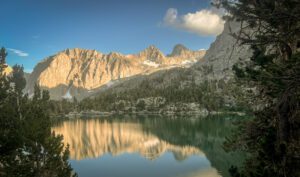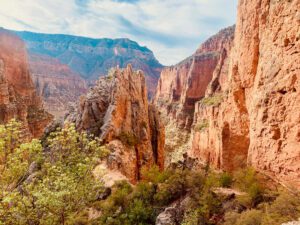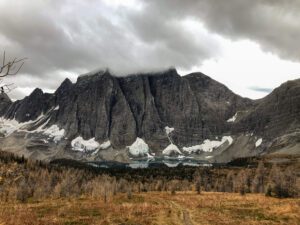Rae Lakes loop is one of the most coveted backcountry permits in Sequoia & Kings Canyon National parks for a reason. For 41 miles (66 KM) you’ll be treated to an endless supply of Sierra Nevada superlatives. You’ll hike alongside the roaring South Fork Kings River, experience the cascading torrent of Mist Falls, marvel at the sublime sunrise reflection of the Painted Lady in Rae Lakes, and experience elation summiting 11,978′ (3651m) Glen Pass.
Rae Lakes Loop can be completed in multiple directions and on a variety of schedules. In this guide, I’ll break down everything you need to know to backpack the Rae Lakes Loop.
** Some of the links in this post are affiliate links. If you click one of the links and make a purchase we’ll earn a small commission at no cost to you. We’re very particular about products and we only recommend products, services, or accommodation we trust and use ourselves.**
Need to know for hiking the Rae Lakes Loop
Days Required: 2-5
Difficulty: Moderate
Distance: 41 miles (66 KM)
Elevation Gain: 7200 ft (2195 M)
Elevation Loss: 7200 ft (2195 M)
Permit Required: Yes, competitive.
Navigation: Easy, trails are well marked.
Water Sources: Plentiful, trail follows reliable creeks and rivers for the duration.
Food Storage: Bear canister required.
Best Campsite walked past or stayed at: Middle Rae Lakes or Upper Rae Lakes.
Things you’ll love about backpacking Rae Lakes
- Sublime Sierra Nevada scenery.
- Well marked and easy to navigate trail
- Loop hike makes transportation a breeze.
- Multiple entry trailheads possible.
- Multiple side trips possible for various itineraries.
- Opportunity to meet other backpackers and thru hikers.
- Plentiful water sources.
Things you won’t love about backpacking Rae Lakes
- Bugs can be viscous.
- Solitude can be hard to find as both the John Muir Trail and Pacific Crest Trail run through the most scenic sections.
- There are bear boxes, yet you need to bring a bulky bear canister regardless.
- Glen Pass can be snow covered until July depending on the snow-pack.
- High elevations may require acclimatization for some.
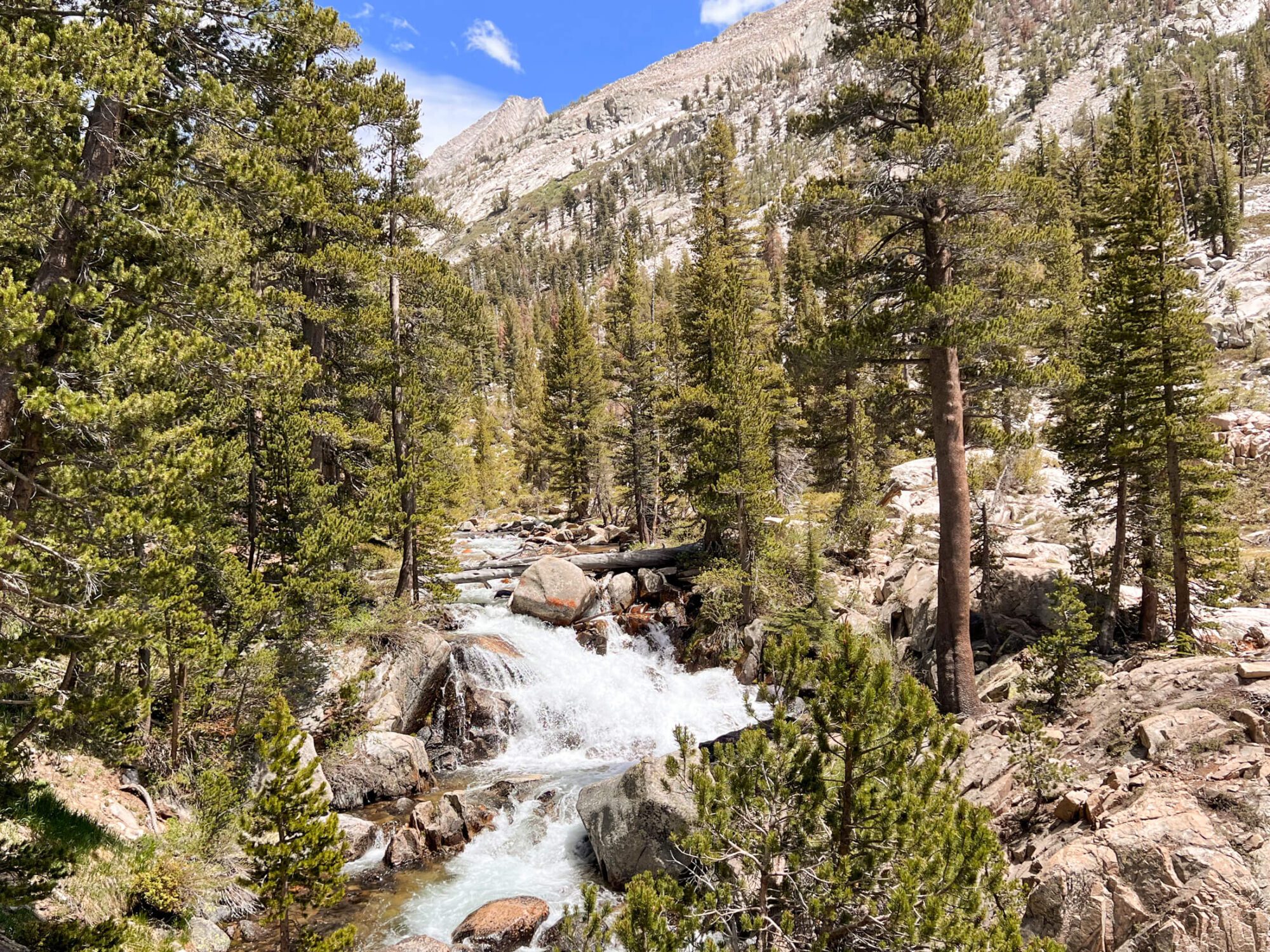
What to pack for backpacking Rae Lakes
Here’s a quick summary of what to pack for backpacking Rae Lakes. You’ll find a detailed breakdown of each item at the end of the post with rational, alternatives and quick links to check prices at competing retailers.
Don’t Forget
- Wilderness Permit
- Bear Canister ** Rangers will check for this
- America the Beautiful Pass (or park entrance pass)
- Travel Insurance with Emergency Medical (if traveling from outside the US)
Essential Items
- Tent – On Sale!
- Backpack
- Sleeping Mat
- Backpacking Pillow
- Sleeping Bag or Quilt
- Water Purification
- Trowel, TP, & Hand Sanitizer
- Swiss Army Knife
- Stove & Fuel Canister
- Lighter & Matches
- Compact Backcountry Cookset & Spork
- Water Bottle or Reservoir
- Extra Water Storage Container (optional)
- First Aid Kit
- Trekking Poles
- Headlamp with red light mode
- GPS, Compass & Map
- Battery Back-Up & Charging Cable
Clothing and Accessories
- Shell Jacket
- Puff Jacket
- Sun Hoodie
- Rainpants (optional)
- Convertible Hiking Pants
- Shorts (1 pair)
- Base Layer Top
- Base Layer Bottom
- Underwear (2-3 pair)
- Hiking Socks ( 3 pair)
- Hat & Beanie
- Sunglasses
- Gloves
- Trail Runners or Hiking Boots
- Camp Shoes (optional)
- Low trail running gaiter (optional)
Additional Items
- Microspikes (season dependent)
- Sunscreen & SPF lim balm
- Bug Spray
- Tooth Brush & Toothpaste tabs in ziplock
- Duct Tape (for repairs and blisters)
- Food – These meals are great
Luxury Items (optional)
How many days does it take to hike the Rae Lakes Loop?
The Rae Lakes Loop typically takes 2 to 5 days to backpack in its entirety. That said, there are many possible side trails for hikers looking to spend more time in the area including Sixty Lakes Basin, Gardiner Basin, and Kearsarge Lakes.
If you’re looking for a shorter, weekend trip the hike to Big Pine Lakes is another excellent option.
How do you get a permit for the Rae Lakes Loop?
During the quota season (May 24, 2024 – September 28, 2024) there are two ways to secure a permit to backpack the Rae Lakes Loop: through a reservation or walk-up permit. Outside of these dates all permits are self-issued at the nearest visitor center.
The classic Rae Lakes loop starts at Road’s End in King’s Canyon National park and follows either Bubbs Creek (counterclockwise trips) or Woods Creek (clockwise trips).
How to make a reservation
Permits for Rae Lakes Loop can be booked starting 6 months before and up to one week before your intended start date via recreation.gov. Up to 20 people are allowed to enter via reservation daily on both Bubbs Creek Trail or Woods Creek Trail (40 total). Once you’ve secured your reservation, you’ll still have to pick up your permit from Road’s End Ranger Station starting at 1 pm the day before your hike or as late as 10:00am the day of your hike. If you’re arriving later, contact the wilderness office to let them know to hold your permit or it will be given away.
How to get a walk-up permit
5 people are allowed to enter with walk-up permits daily on either Bubbs or Woods (10 total). These permits can be obtained starting at 1pm the day prior to your hike. If you’re going this route, arrive well before 1pm to snag a spot near the front of the walk-up line. Make sure you have an idea of your itinerary beforehand.
Do you need a park entrance pass if you have a backcountry permit for Sequoia and Kings Canyon?
Yes, you need to purchase an entrance pass to Sequoia and Kings Canyon National Park at the gate or in advance. It’s best to purchase your entrance pass in advance to save time and avoid the line.
Buy an America the Beautiful Annual Pass in advance if you plan on visiting multiple parks or visiting multiple times within a year. Sequoia and Kings Canyon charge $35 per vehicle for a 7 day pass, so it doesn’t take many visits to National Parks or any public lands to pay back the $80 dollar cost.
If this is the only time you’ll be visiting a National Park this year, you can also pre-purchase your 7 day entrance fee at recreation.gov.
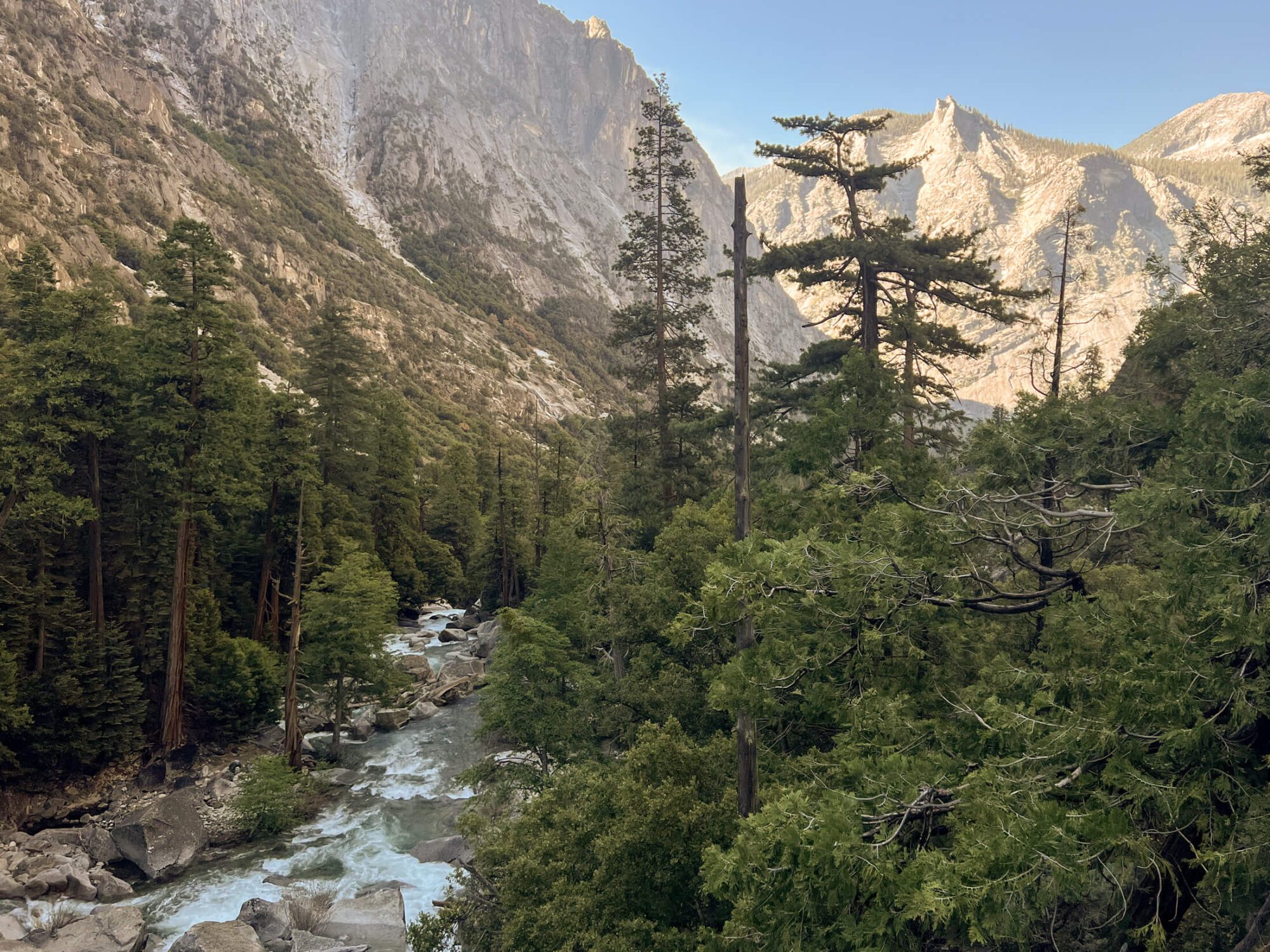
Which direction should you hike Rae Lakes?
Rae Lakes Loop can be hiked either clockwise via Woods Creek Trail or counterclockwise on Bubbs Creek Trail. Prior to booking your permit you’ll need to decide on a direction to hike this trip. Here’s more information to help you make your decision:
Clockwise, from the Woods Creek Trail
Starting your hike from Woods Creek Trail results in a more gradual elevation change. This route spreads the 6943 ft (2100 M) climb to Glen Pass out over almost 25 miles, following a steady upward trajectory with a limited number of drastic switchbacks prior to the big push up to Glen Pass
Counterclockwise, starting from Bubbs Creek Trail
Heading counterclockwise from Bubbs Creek is more strenuous, gaining the 6943’ of elevation to Glen Pass over 17 miles. If choosing this direction it doesn’t take long for the thigh burn to begin with a series of switchbacks greeting you within the first several miles and before the first campsite option at Sphinx Junction.
Verdict on direction
In my opinion, the competitive nature of the permit process doesn’t afford the luxury of being choosy. Either way the hike is fantastic.
If I had to choose, I’d start from Woods Creek Trail (clockwise) for the following reasons:
- Your pack is heaviest with food weight at the start of your trip, so more gradual elevation is a perk.
- Afternoon thunderstorms can be common in the summer. A clockwise trip makes it easy to spend a night at Rae Lakes and summit Glen Pass early in the morning before this becomes a factor.
- Rae Lakes close proximity to Glen Pass makes it easier to go clockwise for those looking to include a night at Rae Lakes in their itinerary.
Additional trailhead options for hiking the Rae Lakes loop:
Aside from Bubbs Creek and Woods Creek there are several additional access points for starting the Rae Lakes Loop on the eastern side of the Sierras. Starting from these trailheads will add additional mileage, but may afford you the opportunity to get a permit that might not otherwise be available.
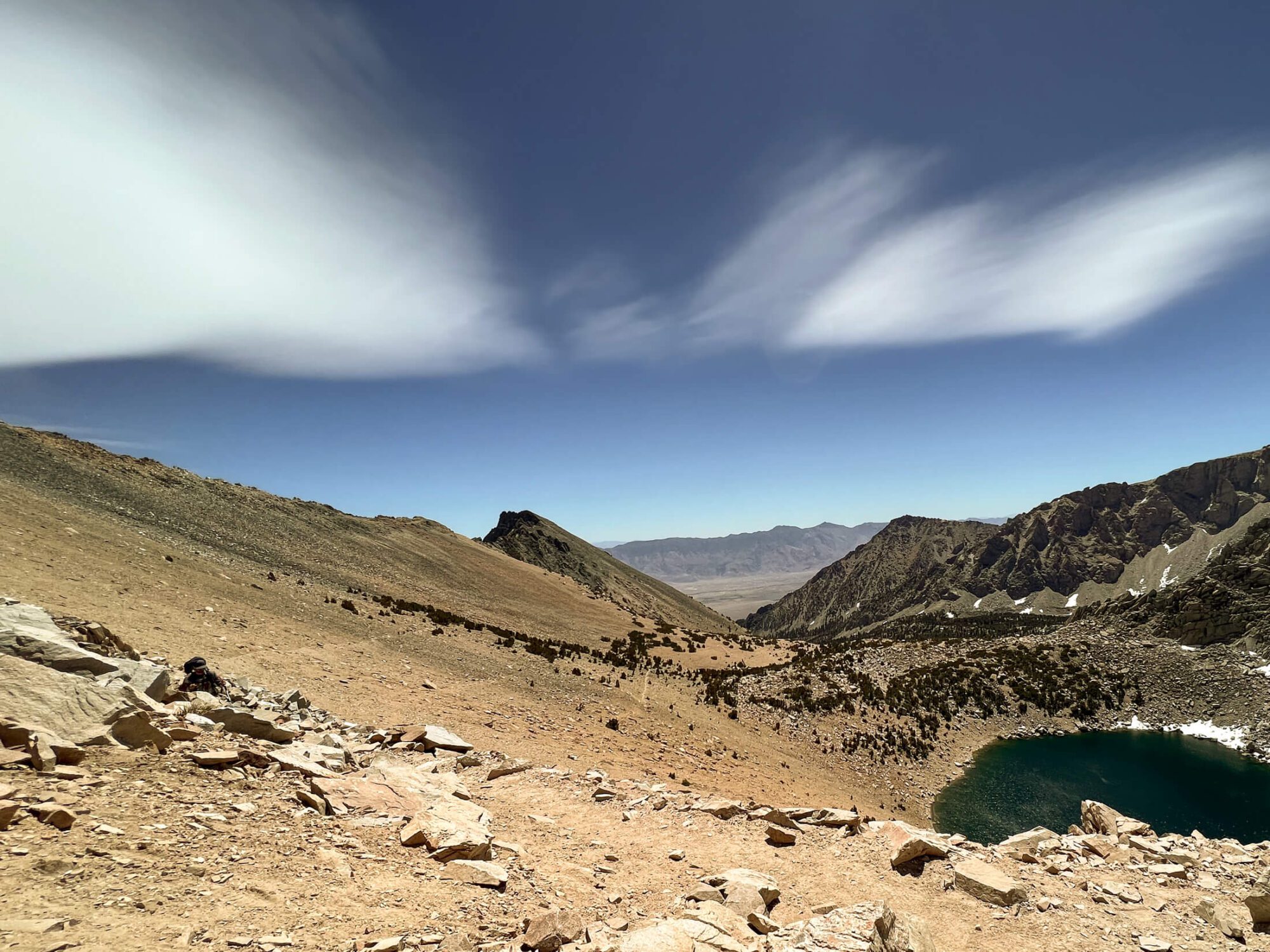
Kearsarge Pass via Onion Valley
The most common alternative trailhead for doing the Rae Lakes Loop, this trail starts from Onion Valley on the eastern side of the Sierras and climbs up and over Kearsarge pass. At 6.5 miles (one-way), it’s a great option and a common resupply trip for thru hikers on the Pacific Crest Trail and the John Muir Trail. This trail offers stunning views of the Kearsarge lakes area on the descent from Kearsarge Pass. Permits for the Rae Lakes Loop starting from Kearsarge Pass must be booked through the Inyo National Forest – Wilderness Permits.
Baxter Pass via Baxter Pass Trailhead
This strenuous 13 mile (one-way) route takes you over Baxter Pass before dropping you down by Dollar lake to the North of Rae Lakes. I have no personal experience hiking over Baxter, but my map marks it as a route (vs. a trail) and the official National Forest description calls it steep and rugged. Buyer beware! Drop me a line in the comments if you’ve done it, would love to hear about it. Starts from the Baxter Pass trailhead and is booked via the Inyo National Forest – Wilderness Permits on Recreation.gov.
Can you have campfires on the Rae Lakes Loop?
Yes, campfires are allowed on sections of the Rae Lakes Loop below 10,000 ft and assuming current fire regulations allow it. The elevation restriction means that fires are never permitted in the section of the trail that starts in the vicinity of Dollar Lake (including Rae Lakes) and ends near lower Vidette Meadow (if traveling clockwise). If you’re making a fire in the allowable areas make sure to follow minimum impact principles, use only existing fire rings, and ensure it’s doused repeatedly, cold to touch, and dead out before hitting the sack. Check with a ranger for all up to date restrictions before heading out.
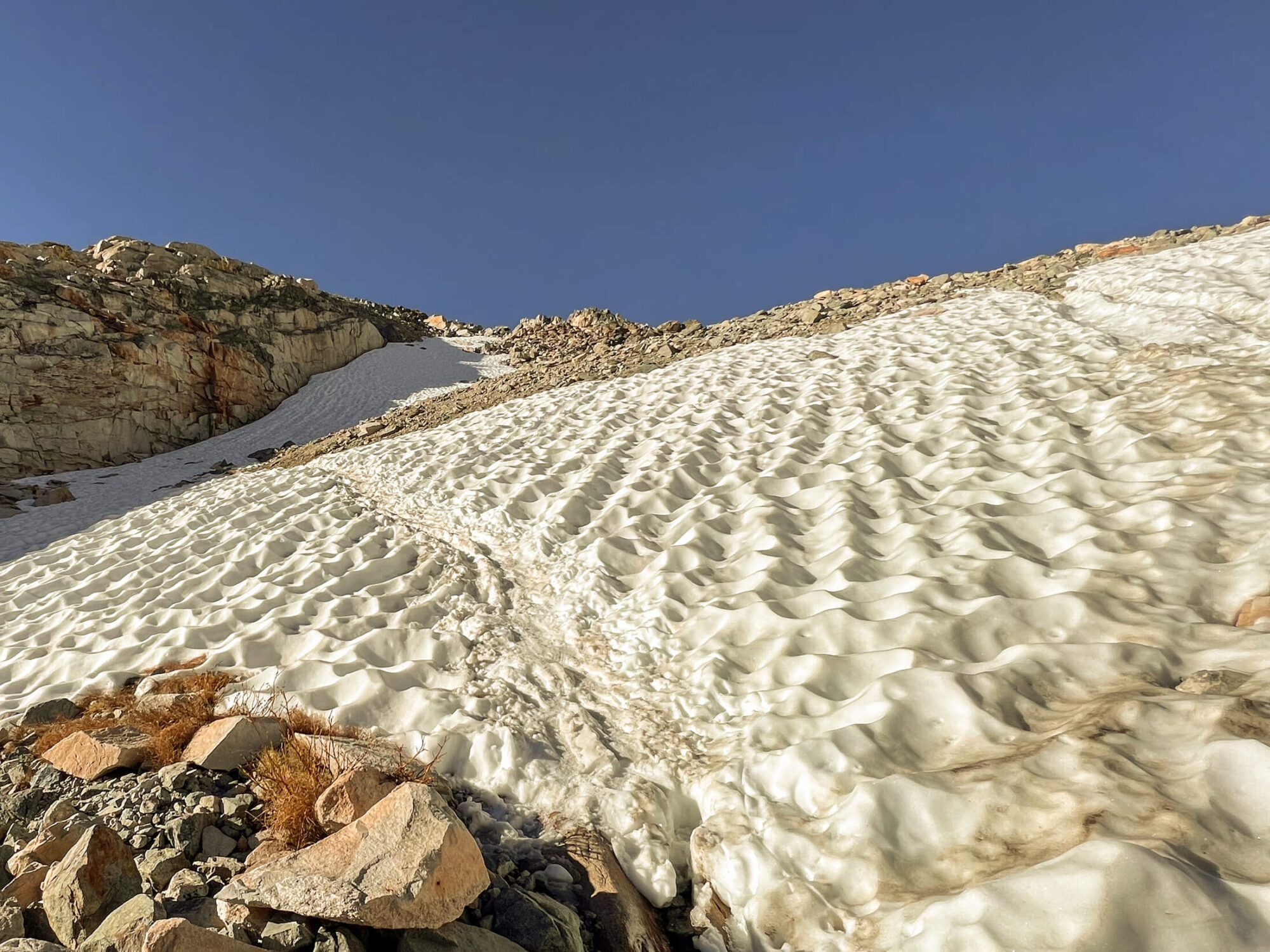
Is the hike to Rae Lakes challenging?
Like any hike the difficulty of hiking the Rae Lakes Loop is very subjective. Your conditioning, experience, and backpack weight are all major factors. Overall, I’d rate this hike as moderate. It’s well signed and offers multiple campsites to break the mileage up over multiple days. That said, there is significant elevation gain up to the highpoint at Glen Pass and its’ difficulty is compounded by the high elevation that comes with hiking in the Sierra Nevada. Furthermore, the potential for snow travel and river crossings in early season increases the difficulty level.
When to backpack the Rae Lakes Loop
The Rae Lakes Loops can be hiked from early-June through to October. The sun in the altitude of the High Sierra is intense during the peak summer months and thunderstorms may pose a risk. Early season travel faces the challenge of snow on Glen Pass and potential for dangerous river crossings. In fall, temperature begin to drop and the potential for snow rises. If going early or late season, contact the wilderness office for questions on conditions. At all times of the year the trail will be heavily trafficked. Aside from Rae lakes being a popular backpacking destination in its own right, trail joins the John Muir Trail and Pacific Crest Trail for about 14 miles from Lower Vidette Meadow to Woods creek bridge.
How to get to the Rae Lakes Loop?
The traditional Rae Lakes Loop starts from Road’s End in Kings Canyon National Park. It can also be started from multiple other trailheads on the eastern side of the Sierras. It’s a loop hike and thus no shuttle is required. Rent a car or drive your own, park at the trailhead and go nothing beats easy logistics! Am I right?
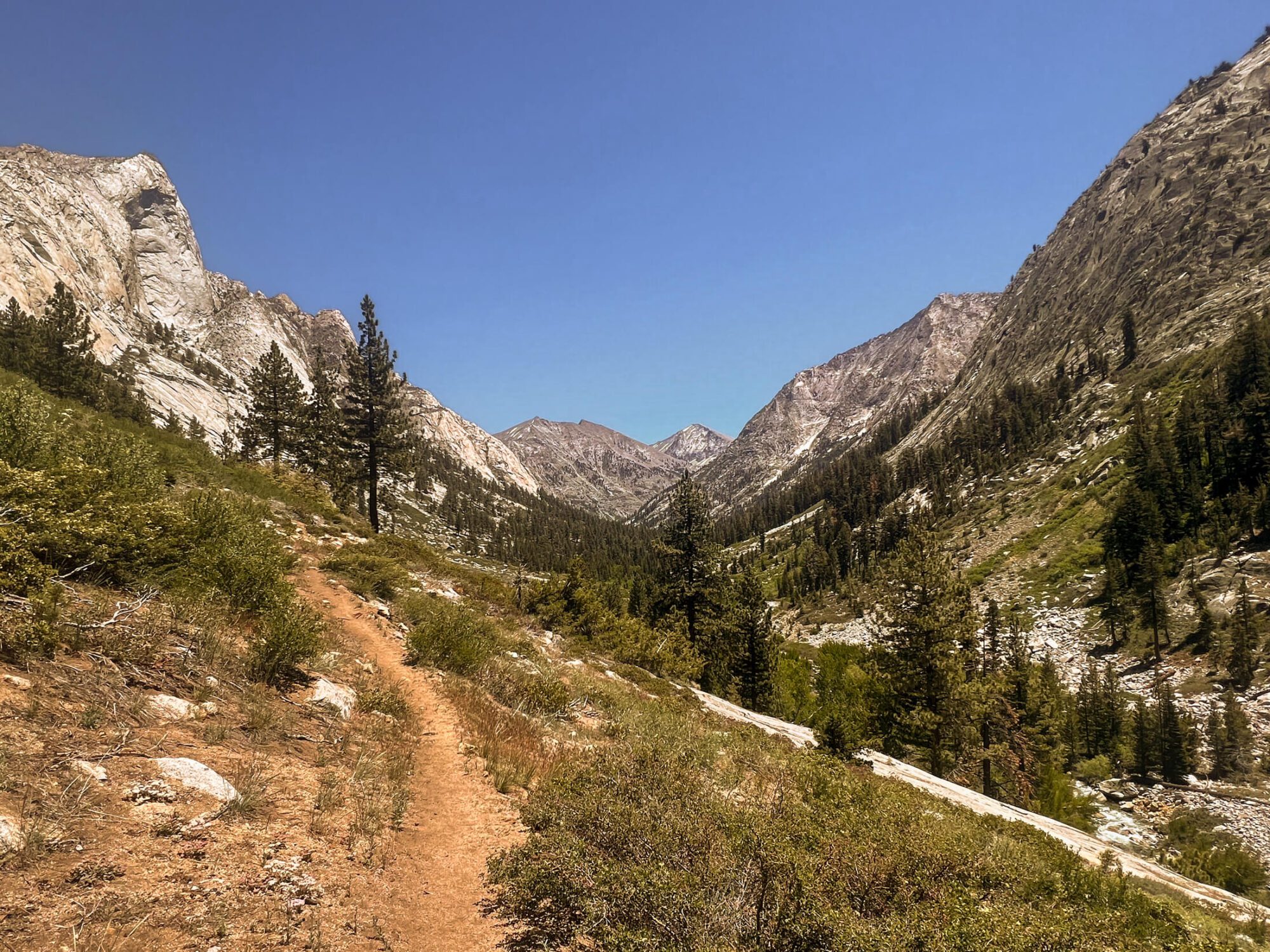
Where to stay before hiking the Rae Lakes Loop
Arriving the day before to pickup your permit or looking to explore before your hike? Staying near to Road’s End in the Cedar Grove area is extremely convenient and there are several accommodation options that can facilitate this. Make sure to book these early as they fill up quickly during the busy summer months.
Camping Options
Several campsites are conveniently situated in the Cedar Grove area making car camping the night before (or after) a snap . Book any of these sites through recreation.gov
Sentinel Campground – I stayed here the night before my hike. It’s a decent site, but many of the sites feel close together.
Similar and next to Sentinel in Cedar Grove are Sheep Creek and Moraine Campground which seem very similar to Sentinel just slightly larger.
If these options are full, consider Azalea Campground, Crystal Springs Campground, or Sunset Campground in Grant Grove about an hours drive from Roads End.
Lodging Options
If you feel like getting off your thermarest and out of the tent for a night here are few great options:
Cedar Grove Lodge – Only 5.9 miles from Road’s End in Kings Canyon this is the most convenient option for spending the night before your hike.
For other options inside Kings Canyon National Park check out John Muir Lodge or Grant Grove Cabins about an hour away from Road’s End in Grant Grove Village.
Trail sections
I’ve described the sections of the Rae Lakes Loop based on my own experience hiking clockwise. If you’re planning a trip the opposite way you’ll have to get creative and try to think backwards. All distances and elevations are rounded and approximate.
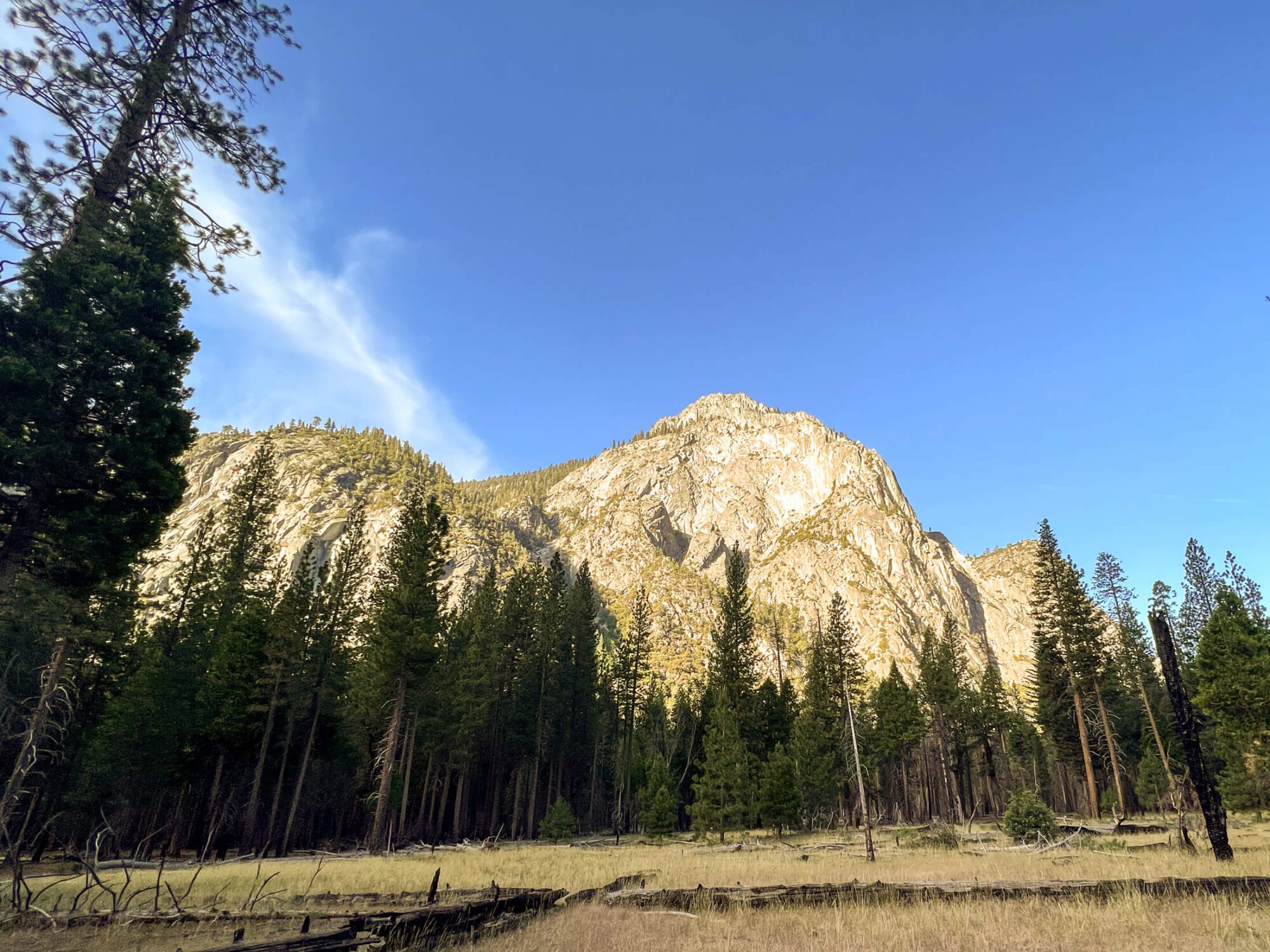
Roads End to Mist Falls
4 Miles (6.5 KM)
850ft (250M) Elevation Gain
After departing from the Road’s End Ranger Station the trail follows a wide path through an open forest with excellent views to cliffs and peaks surrounding the canyon. Sun exposure in this section is high and shade is limited. After a couple miles, you’ll hit the junction for Bubb’s Creek trail where counterclockwise hikers take a right crossing the bridge over the South Fork Kings River. Clockwise hikers continue along the Paradise Valley trail which follows along the rivers west bank, The trail becomes quite lush with the moisture, nutrients, and spray from the river transforming the forest and providing some shade. The contrast is stark, where minutes ago there was a sandy wash, ferns and significant understory abounds. For 2 miles after the Junction with Bubbs the trail steadily climbs adding about 650ft (200 M) elevation before reaching the aptly named Mist Falls where an incredible torrent of water shrouds the entire trail in vapor and mist. This is a spectacular and refreshing location for lunch or a snack, just be mindful of the slippery rocks.
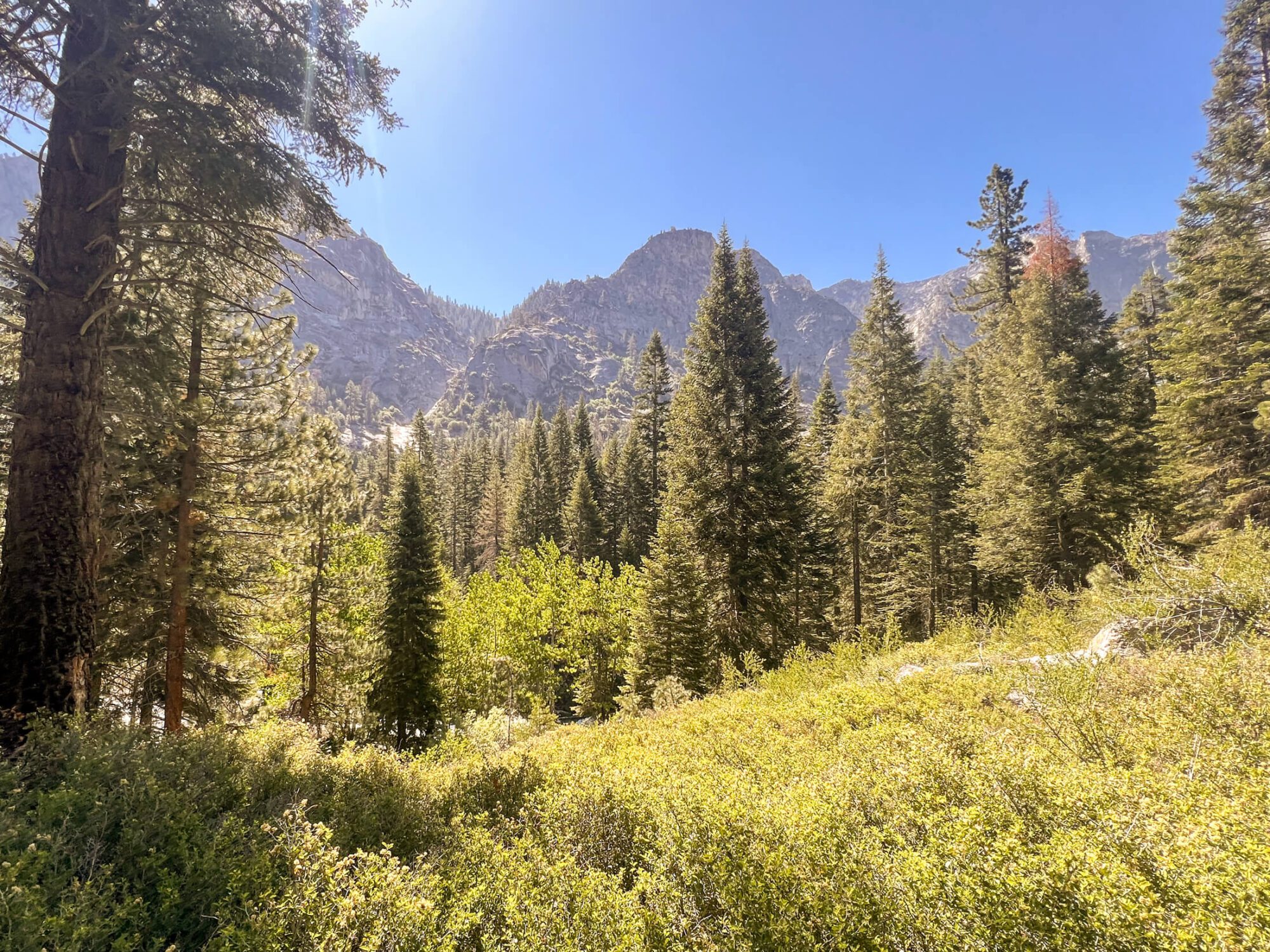
Mist Falls to Upper Paradise
5 Miles (8 KM)
1650ft (450M) Elevation Gain & 350 ft (100M) Loss
Leaving Mist Falls the trail continues its steady ascent navigating a short series of switchbacks half a mile after the falls. Views back down the river valley are spectacular and amplified in the morning as the sun’s rays highlight the canyon walls. The trail follows the river up the drainage as it flows through a series of deep and dramatic pools before widening and shallowing out near Lower Paradise Valley. Lower Paradise Valley is typically the first spot where camping is permitted, but for 2022 it was temporarily closed due to the presence of numerous dangerous trees. If you’re looking to camp in this area for the night continue on to Middle or Upper Paradise . This section of the trail provides numerous forested sections that serve as a lovely reprieve from the scorching Sierra sun. I was fortunate enough to see a bear about 150 ft in front of me on this section. Naturally, he took off the minute he heard me singing…

Upper Paradise to Woods Creek
5.5 Miles (9 KM)
1650ft (500M) Elevation GaIn
After departing Upper Paradise you’ll encounter the largest river crossing of this trip. There was once a bridge that crossed the South Fork Kings River here, but it was washed away in 2016. As of June 2022, there was no new bridge and a stream crossing is required here. The conditions are season dependent and day dependent. I encountered no issues with this crossing in early June , but every year/day can be different. Ask the ranger for any guidance when you pick up your permit as from time-to-time log jams form in the vicinity that can make the crossing easier. Look for the old bridge foundation to give you a bearing of where to head and avoid walking to far. Additionally, once you’ve made the crossing, find the remnants of the old bridge’s concrete foundation again to re-discover the trail. There are a couple trails that lead north (or to the left of the old fountain), do not take these, stay on the trail that heads straight then to the right and you’ll quickly rediscover the main trail. You’re now on the Woods Creek trail! Over the next 6 miles you’ll gain over 1600 ft of elevation (500M) in a steady fashion. Who said going up was hard! Following your crossing, you’ll initially hike out of sight of Woods Creek before the creek becomes visible a couple miles down the trail. Upon reaching Castle Domes Meadows area the views really begin to open up and you’re given a sampling of what’s to come. After staying right at the junction and joining up with JMT/PCT you’ll come to the suspension bridge and cross over Woods creek.
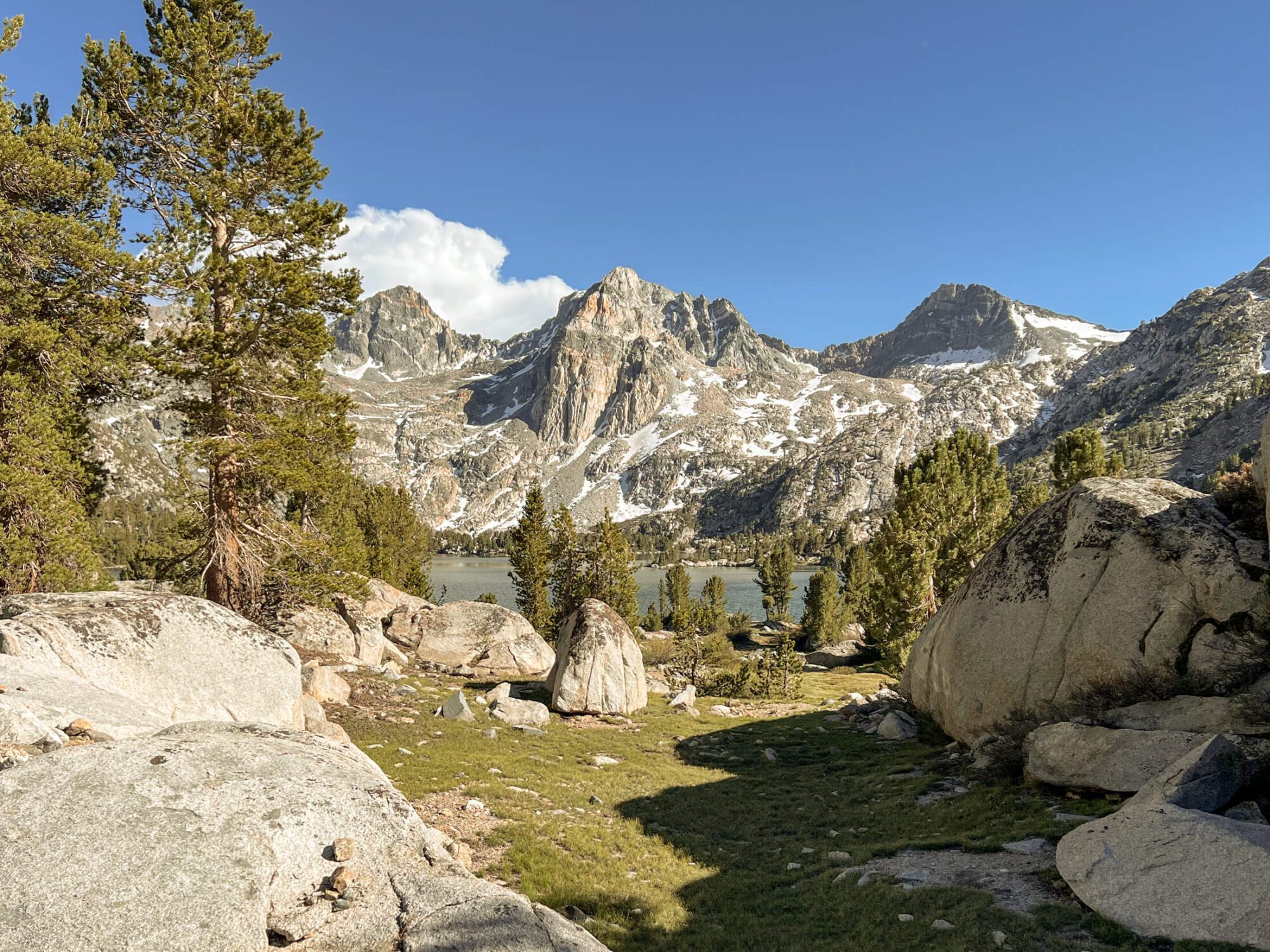
Woods Creek to Middle Rae Lake
6 Miles (10 KM)
2000ft (650M) Elevation GaIn
After crossing the suspension bridge over Woods Creek the trail climbs 1600 ft ( 500 M) to reach Dollar Lake and the junction with Baxter Lakes Trail. This climb is steady over the duration and crosses over various tributaries that flow into the South Fork Woods Creek. None of these crossings are technical and are likely seasonal flows, unfortunately in early June several were not crossable without conceding wet feet. After reaching Dollar Lake the trail remains relatively flat and you’ll cross another small flow that connects Arrowhead Lake with Dollar lake and re-soaks your feet just as they were starting to dry. Arrowhead lake offers a decent size camping zone with food storage boxes, should your legs be too weary to go any further or are looking to avoid the crowd at Rae. Arrowhead is also a great second night option for those looking to stay near Rae Lakes for longer than 1 night. At this point the trail makes one more climb to reach the majestic Rae Lakes. There are several spots to camp near lower Rae lakes, but many backpackers continue past the ranger station to Middle Rae Lake. Camping here provides an optimal view over Middle Rae Lake to the Painted Lady and peaks behind. Sunset and sunrise here is guaranteed to delight!
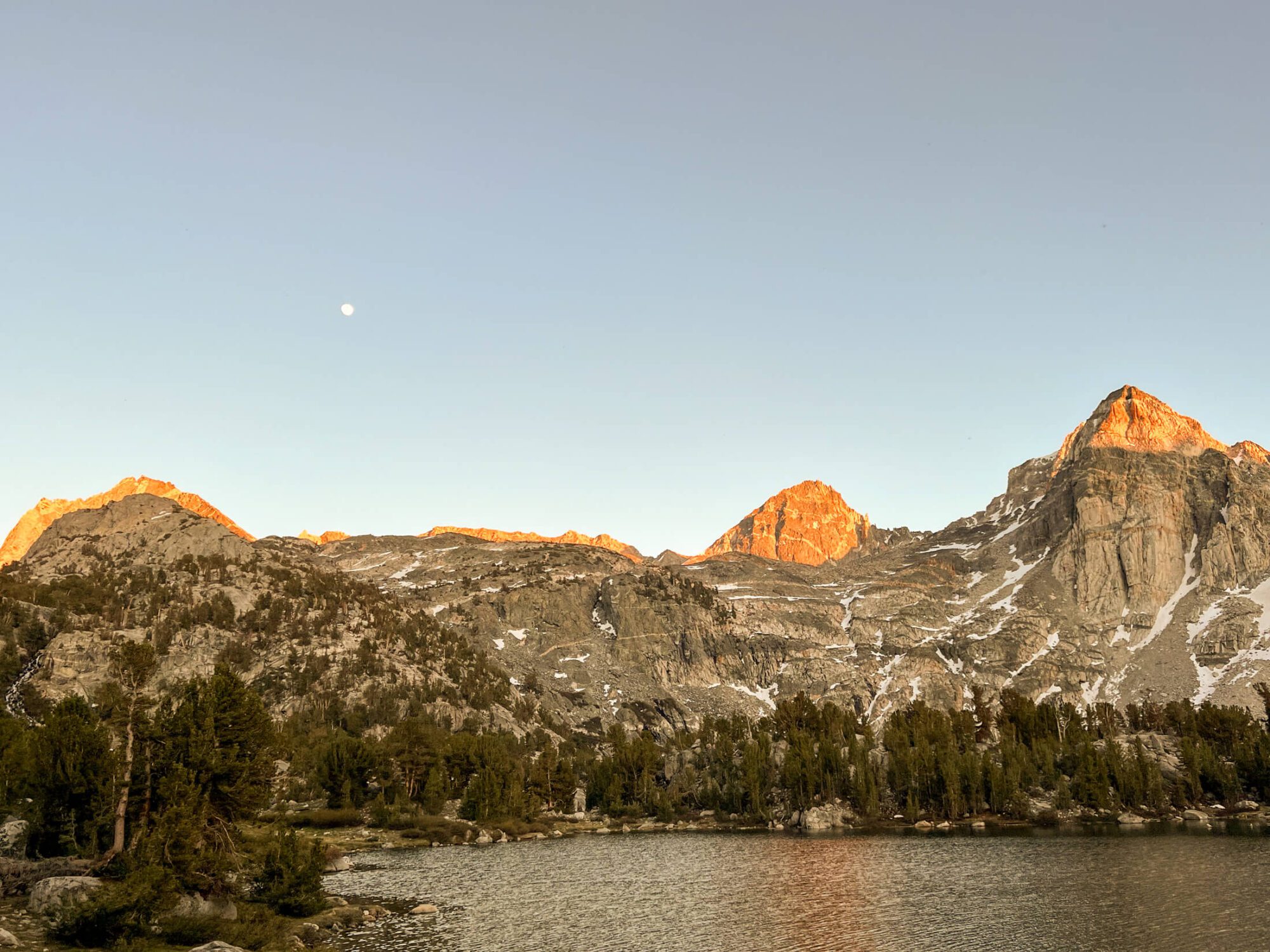
Middle Rae Lakes to Glen Pass
2.5 Miles (4 KM)
1500ft (450M) Elevation Gain
If you’ve stayed at Middle Rae, you’ll start your day with incredible views as you follow the shoreline along the northern side of Upper Rae Lake. After walking for about ½ mile (1 KM) you’ll encounter another small water crossing where Upper Rae drains into Lower Rae. There were no rocks to cross during my trip. If you have an alternate pair of shoes/sandals you’ve been using for river crossings, I’d consider wearing them from camp to this point given. It’s a short distance and you’ll save the hassle of making the change. If not, embrace the morning footbath! Shortly after negotiating this crossing you’ll encounter the junction for the Sixty Lakes Basin to the right, a great place to explore for those spending additional time in the area. If not, continue to the left, it’s time to tackle Glen Pass! From Upper Rae Lakes the trail gains 1500ft (450 M) over 1.8 Miles (3 KM) to the trail’s highest point at Glen Pass. This ascent is negotiated over a series of switchbacks that climb over loose rock and snow, in the early-season. If you’re hiking early in the year, this is where you’ll want your microspikes so have them ready. An early morning start is also helpful, as the snow is firm and far less strenuous to navigate without postholing at every step. Regardless of the season, It’s tough work making the climb, but the awe-inspiring views of alpine lakes and jagged peaks are balm to your burning quads. Following a final step set of switchbacks the trail cuts across sharply skirting the ridge to the right before reaching the summit of the pass. Be especially careful here if traveling on snow or ice as the slope to the right is steep and a fall would have consequences. After navigating this final section, take it all in. A breathtaking view greets you in all directions!
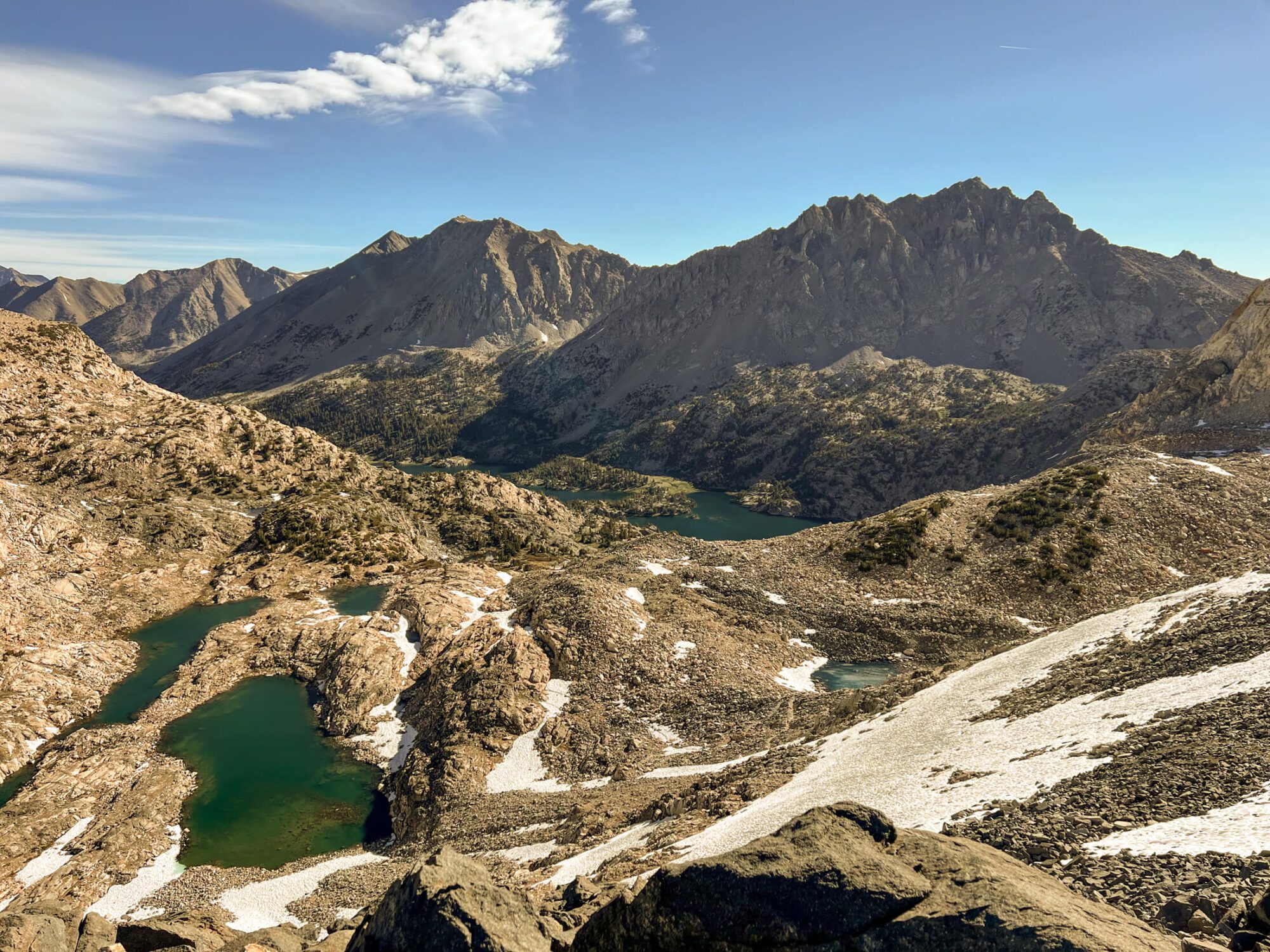
Glenn Pass to Charlotte Lake Junction
2 Miles (3.5 KM)
1300 ft (400M) Elevation Loss
After enjoying your time atop Glen Pass, it is time to begin your descent. The path coming down navigates a series of switchbacks, but without the same level of loose rock as your ascent. Additionally, this slope south facing exposure makes it unlikely that you’ll encounter any more snow travel. You’ll descend towards a small alpine lake for around ½ mile rapidly losing 350 ft (100 M) of elevation along the way. After this first lake the trail follows along a small creek that drains into a lower lake about 1 Mile (0.6 KM) down. There are several camp spots nearby these small lakes that may be useful for hikers traveling counterclockwise and looking to get an early start going up Glen Pass. After passing the second lake, you’ll slowly leave behind the alpine environment and continue for another 1.2 miles (2.0 Km) losing 525ft (160 M) of elevation before reaching the trail for Kearsarge Pass. Kearsarge pass makes for an excellent alternative entry point or add on loop (9 KM round trip to the pass) that takes in scenic views from the pass, Kearsarge Lakes and Bullfrog Lakes. Staying on the main trail you’ll continue for ¼ mile (0.35KM) before coming to another junction with Charlotte Lake trail. Charlotte lake lies ⅔ Mile (1 KM) to the right with this trail also serving as the access point for exploring the Gardiner Basin area.
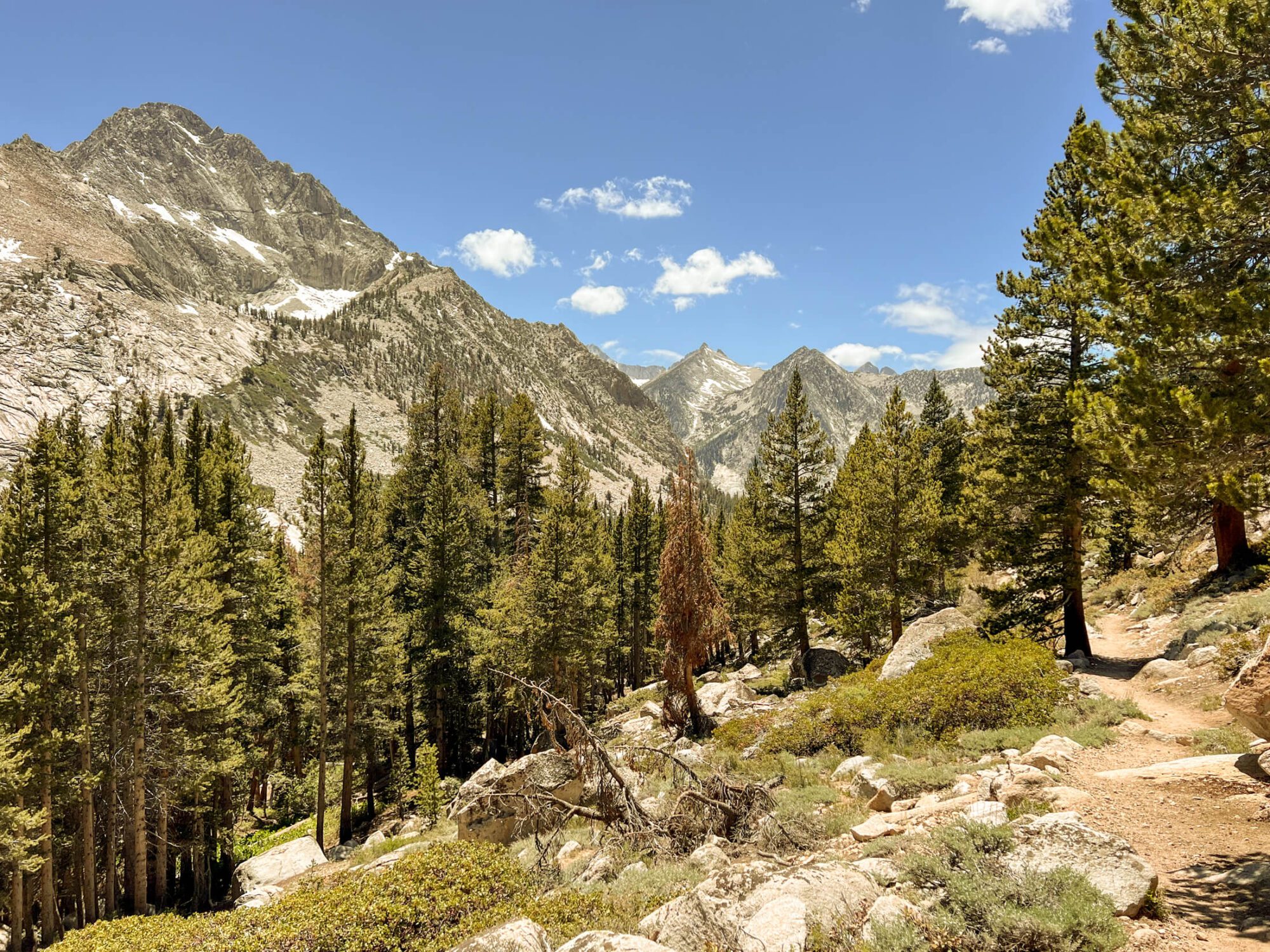
Charlotte Lake Junction to Junction Meadow
4 Miles (6.5 KM)
2600ft (800 M) Elevation Loss
Following the junction with Charlotte Lake, you’ll encounter a series of switchbacks before continuing a steady descent alongside a creek and down the valley. From Charlotte junction you’ll lose 360M of elevation in 2.7km walking through forested areas with consistent openings to the mountains above and valley below before reaching Vidette Meadow junction . Upon reaching Vidette Meadow junction you’ll stay right following the Bubbs creek trail and bidding adieu to PCT and JMT trails as they exit to the left. From here the trail parallels Bubbs creek as it descends providing innumerable magnificent views of the crashing torrent as it descends down into the valley below. About 4km after lower Lower Vidette meadow you’ll arrive at Junction meadow. For those looking to cover move ground, an excellent camping spot with bear boxes lies an extra 0.6 miles down the trail adjacent to Bubbs Creek.
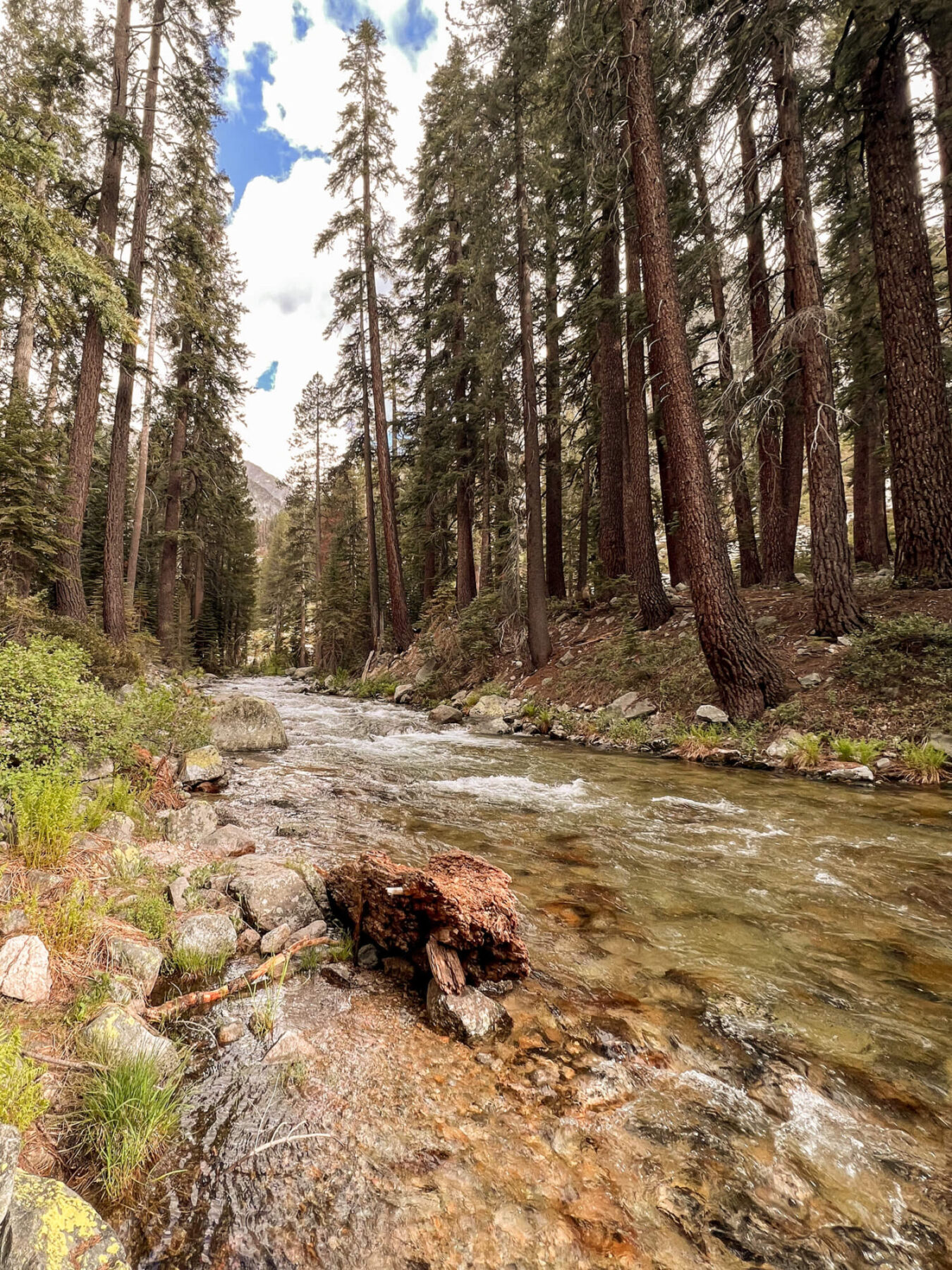
Junction Meadow to Sphinx Creek
6 Miles (10 KM)
2000ft (600 M) Elevation Loss
Leaving Junction meadow you’ll continue to parallel Bubbs Creek and walk through a mix of forest and meadow. Catch views of the surrounding cliffs that encircle the valley walls and marvel at the perfectly eroded drainages where spring runoff funnels down into Bubbs creek. After 3 miles (4.8 KM) and a 300M loss in elevation you’ll reach Charlotte Creek which offers a collection of campsites to the left of the trail and near Bubbs Creek. As you continue past this area and down to Sphinx Creek look for the looming silhouette of Charlotte Dome (10,630 ft 3240 m) to the right. A further 3.3 Miles (5KM) down the trail you’ll come to a junction at Sphinx Creek. The Campsite here is the last (first) place to camp if completing this hike Clockwise (counterclockwise).
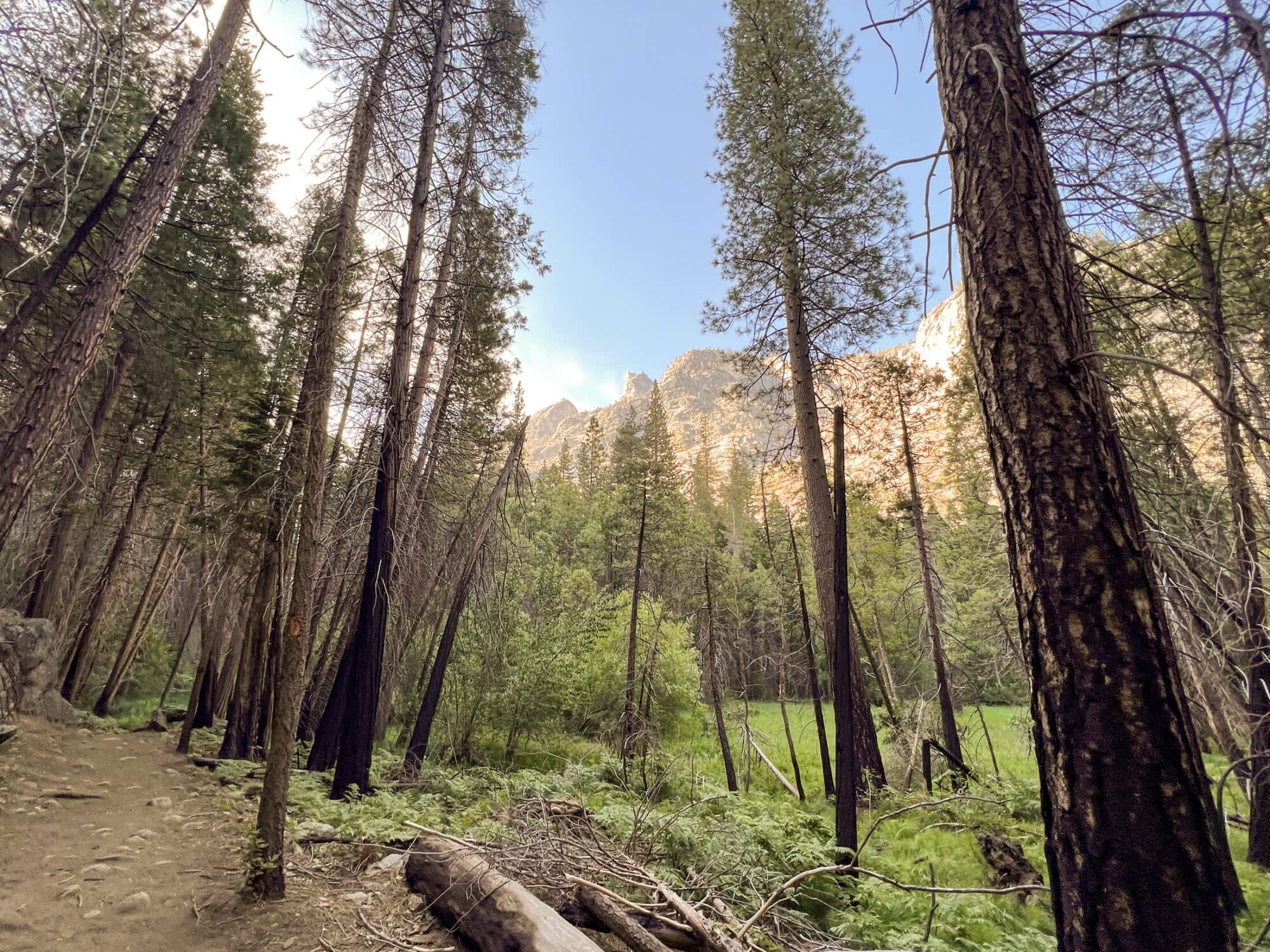
Sphinx Creek to Road's End
4 Miles (6.5 KM)
1300 ft (400 M) Elevation Loss
From Sphinx you’ll walk for about ⅔ of a mile (1KM) before encountering your final set of switchbacks. As you descend, look for views of the Sphinx 2786M to the southwest. Once you’ve reached the bottom of the switchbacks you’ll make your way across Bubbs Creek (unbridged) before crossing the bridge over South Fork Kings River and retracing your steps back to Road’s end and your car.
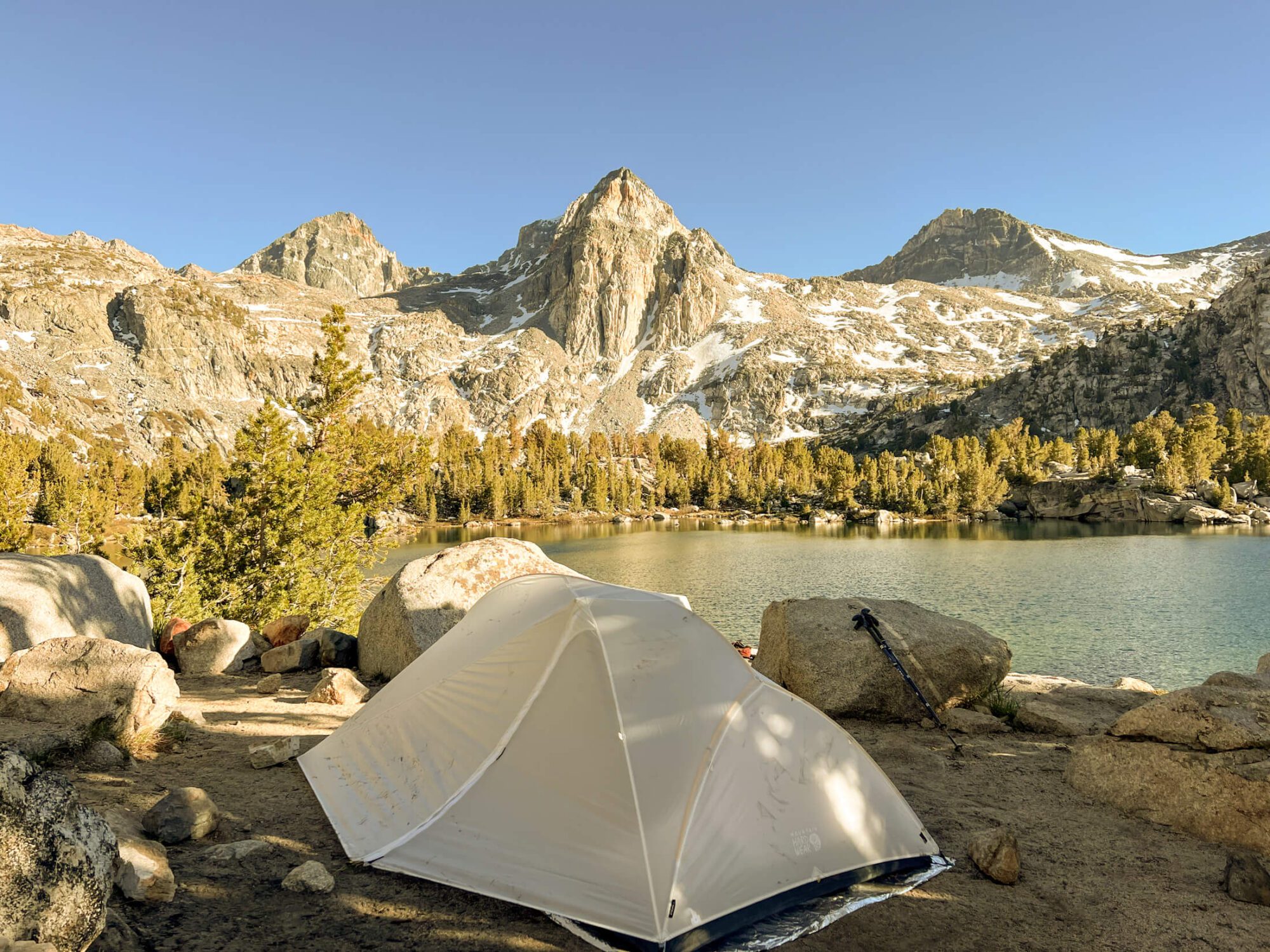
Campsites on the Rae Lakes Loop
Unlike popular treks like the Grand Canyon’s rim to rim, there are no truly established campsites on the Rae Lakes Trail. Specifically, you will not have luxuries like tent pads or outhouses, but you have the luxury of getting to camp (mostly) where you please! There are multiple locations that are frequently utilized by backpackers and often feature well used/obvious tent sites, food storage boxes, and established fire rings. Bear canisters are mandatory for hiking the Rae Lakes Loop and priority in the food storage boxes is given to thru hikers on the PCT and JMT. However, if there is room many hikers pop their bear canisters inside to make it easily discoverable and eliminate the risk that a bear will accidentally roll your cache into a nearby lake or river should it attempt to get inside. You’ll find food storage boxes at the following locations:
- Sphinx Creek
- Charlotte Creek
- Lower Junction Meadow
- Junction Meadow (East Creek)
- Vidette Meadow
- Woods Creek crossing/John Muir Trail
- Upper Paradise Valley
- Middle Paradise Valley
- Lower Paradise Valley
- Arrowhead Lake
- Middle Rae Lake
Itinerary options for hiking Rae Lakes
The traditional Rae Lakes Loop can be completed in 2 to 5 days, but numerous side-trails offer multiple ways to spend more time exploring this incredible area. The following itineraries have been provided as a starting point for helping you plan your trip. Only you know what mileage you’re comfortable with, so make an informed decision. Hiking and backpacking are rare activities where faster isn’t necessarily better or more enjoyable. The last thing you want is to be stressing out about whether or not you’ll make it to camp before dark.
Please note the following restrictions when planning your trip and check for up to date restrictions prior to booking and starting your trip:
- Camping in Paradise Valley is limited to two nights.
- Camping at Rae Lakes is limited to one night per lake.
- No camping at Lower Paradise Valley due to the number of dead trees in the area.
All mileages and elevations are rounded and approximate.

Rae Lakes Loop in 2 days / 1 night
Crazy? Maybe a little, but trail runners tackle the Rae Lakes Loop in one day of quad destroying bliss. So, if you’re really short on time and are comfortable logging high miles in the High Sierra this trip is for you.
Clockwise via Woods Creek
- Day 1: Road’s End to Middle Rae Lakes via Woods Creek
- 21.5 Miles (34 KM)
- 5900 ft (1800 M) Elevation Gain
- 300 ft (100 M) Elevation Loss
- Day 2: Middle Rae Lakes to Road’s End via Bubbs Creek
- 19 Miles (31 KM)
- 1600ft (500 M) Elevation Gain
- 7200 ft (2200 M) Loss
Notes:
In this short of time, clockwise is the way to go as it allows you to spend a night at the loop’s namesake (Rae Lakes) and get up and over Glen Pass first thing in the morning on day 2. Going up Glen first has a number of benefits including: reducing the chance of having to delay due to midday thunderstorm and not having to conquer the toughest part of the trail at the end of a long day when you’re fatigued. If you’re going with this itinerary, I’d start as early as possible. I completed this same schedule on my first day hiking to Rae Lakes. I picked up my permit at 7:00am and finished at middle Rae Lake shortly after 5:00pm with about 30-45 minutes of stoppage time (for lunch/snacks). It felt tough, but manageable. On the 2nd day it’ll be all downhill after completing Glenn pass as your first order of business and you should be back at Road’s end in the late afternoon/early evening, leaving you plenty of time to drive home, get a few hours sleep, and make that early morning Zoom meeting the next day. Weekend warrior this trip was built for you!
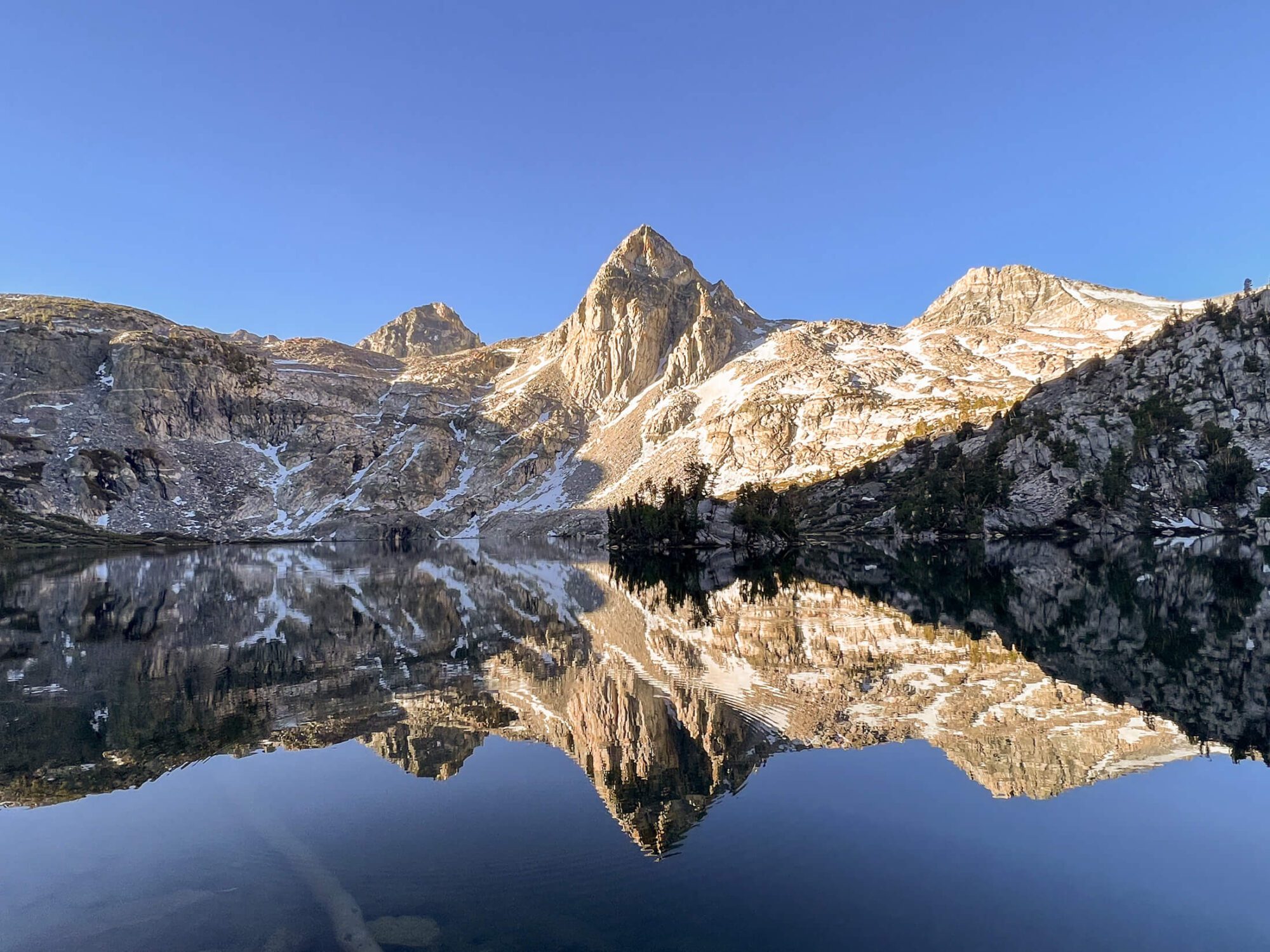
Rae Lakes in 3 days / 2 nights
There are a couple ways to complete this backpacking trip in 2 nights. If you cannot live with the FOMO of hiking to Rae Lakes and not camping there you will need to have one really big day and 2 medium days. If you’re alright with passing by Rae Lakes and not camping there you can spread the mileage over the three days on the trail.
Here are the options:
Option 1 - Clockwise via Woods Creek and camp at Rae Lakes
This is the choice for you if you MUST camp at Rae Lakes! I get it, this was me. Here’s how to do it:
- Day 1: Road’s End to Middle Rae Lakes via Woods Creek
- 21.5 Miles (34 KM)
- 5900 ft (1800 M) Elevation Gain
- 300 ft (100 M) Elevation Loss
- Day 2: Middle Rae Lakes to Junction Meadow, Charlotte Creek, or Sphinx Creek
- 9.5 Miles (15 KM) to Junction
- 1600 ft (500 M) Elevation Gain
- 4000 ft (1200 M) Elevation Loss
- Day 3:Junction Meadow, Charlotte Creek, or Sphinx Creek to Road’s End via Bubbs Creek
- 9.5 Miles (15 KM) to Junction
- 3200ft (1000 M) Elevation Loss
Notes:
Similar to the 1 night itinerary, clockwise is the way to go as it allows you to spend a night at Rae Lakes and get up and over Glen Pass first thing in the morning on day 2. By knocking off Glen Pass first thing you reduce the chance of delay due to midday summer thunderstorms and avoid having to complete the toughest part of the trail at the very end of a long day.
Day 2 gives you some flexibility on the final campsite, allowing you to lengthen the day and subsequently reduce your hike out on day 3 should you desire. If you’re itching for more miles, trips to Charlotte Lake or Kearsarge Pass/Lakes can easily be added to the second day. This is pretty much the itinerary I hiked, except I added a loop trip to Kearsarge Pass, Kearsarge Lakes and Bullfrog Lake to Day 2.
Option 2 - Clockwise via Woods Creek with even-ish mileage
- Day 1: Road’s End to Woods Creek Crossing via Woods Creek
- 16 miles (25 KM)
- 3900 ft (1200 M) Elevation Gain
- 300 ft (100 M) Elevation Loss
- Day 2: Woods Creek to Junction Meadow
- 16 miles (25 KM)
- 3600 ft (1100 M) Elevation Gain
- 4000 ft (1200 M) Elevation Loss
- Day 3: Junction Meadow to Road’s End via Bubbs Creek
- 9.5 Miles (15KM)
- 3300 ft (1000 M) Elevation Loss
Notes:
If you’re looking to space the mileage out, this itinerary splits the elevation gain almost equally between the first and second days while leaving the shorter day for the final day to get where you need to go post hike. Downside is that you don’t get to camp in the alpine areas which are, in my opinion, the most scenic.
Option 3 - Counterclockwise via Bubbs Creek with even-ish mileage
- Day1: Road’s End to past Charlotte Lake Junction via Bubbs Creek . Stay near one of the small lakes about 1.5 Miles (2.5 KM) North of Charlotte Lake Junction and before Glen Pass.
- 16 Miles (25 KM)
- 6600 ft (2000 M) Elevation Gain
- Day 2: Charlotte Lake Junction area to Upper Paradise
- 16 Miles (25 KM)
- 1000ft (300 M) Elevation Gain
- 5300 0ft (1600 M) Elevation Loss
- Day 3: Upper Paradise to Roads End
- 9 Miles (14 Km)
- 2300 ft (700 M) Elevation Loss
Notes:
This itinerary will park you very close to Glen Pass for day 2 and you get the majority of the tough mileage out of the way on a tough day 1. The mileage is more evenly distributed, but this first day will be very tough.
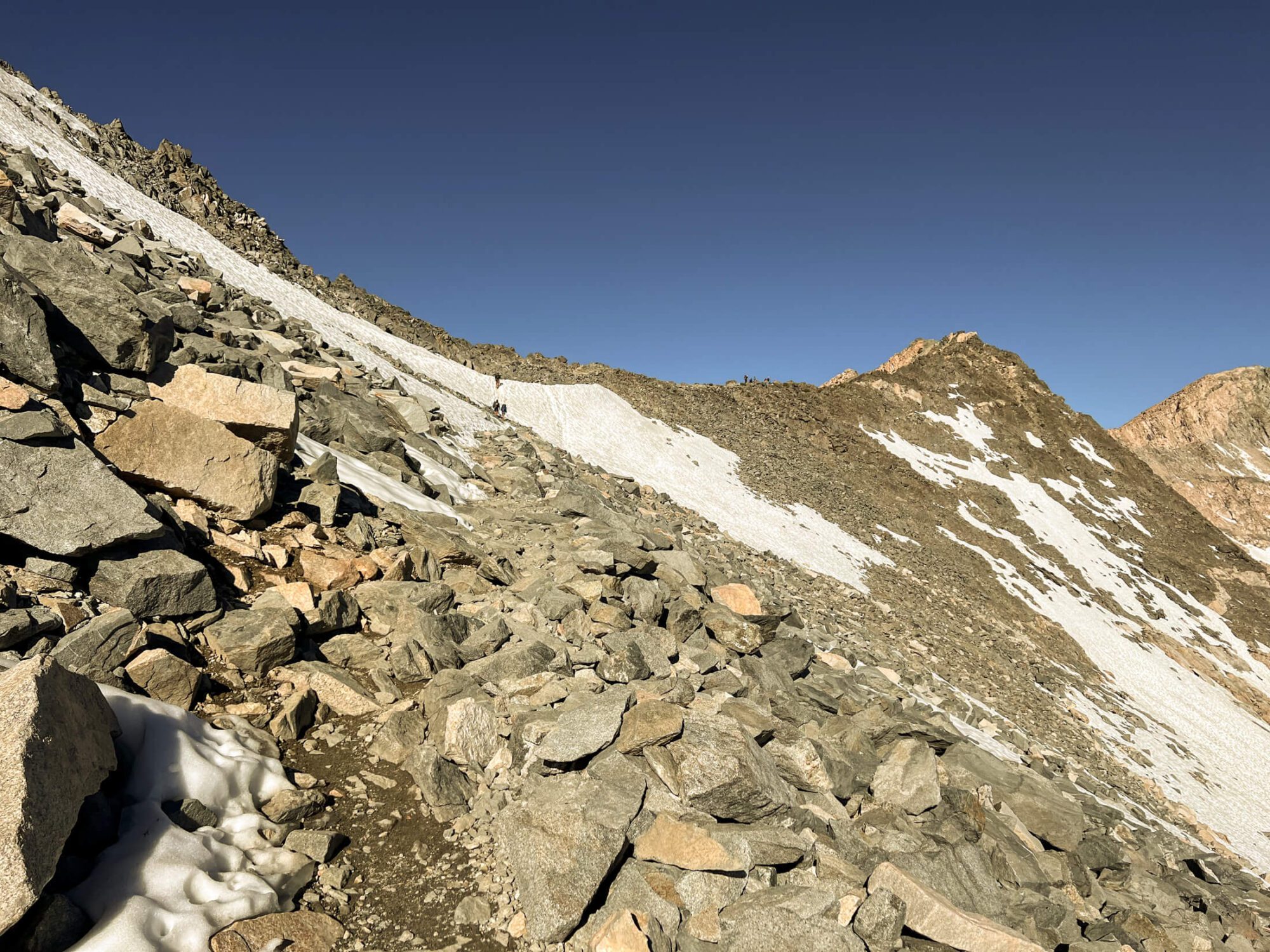
Rae Lakes in 4 days / 3 nights
Completing the Rae Lakes Loop in 4 days / 3 nights seems to be the Goldiloks zone for many backpackers. Here are couple options to do it in this timeframe:
Option 1 - Clockwise via Woods Creek
- Day 1: Road’s End to Upper Paradise
- 9 Miles (14 Km)
- 2300 ft (700 M) Elevation Gain
- Day 2: Upper Paradise to Middle Rae
- 12 Miles (19 KM)
- 3600 ft (1100 M) Elevation Gain
- 300 ft (100 M) Elevation Loss
- Day 3: Middle Rae to Junction, Charlotte Creek, Sphinx.
- 9.5 Miles (15 KM) to Junction
- 1600 ft (500 M) Elevation Gain
- 4000 ft (1200 M) Elevation Loss
- Day 4: Junction Meadow, Charlotte Creek, or Sphinx Creek to Road’s End via Bubbs Creek
- 9.5 Miles (15 KM) from Junction
- 3200ft (1000 M) Elevation Loss
Notes:
There are tough days in this itinerary, but the mileage is manageable for most backpackers.. You get to enjoy the splendor of Rae Lakes for a night and can summit Glen Pass in the morning. A winning itinerary, if I say so myself.
Option 2 - Counterclockwise via Bubbs Creek
- Day 1: Road’s End to Lower Vidette Meadow
- 13 Miles (20 KM)
- 4600 ft (1400 M) Elevation Gain
- Day 2: Lower Vidette Meadow to Middle Rae Lake
- 7 Miles (11 KM)
- 2600 ft (800 M) Elevation Gain
- 1600 ft (500 M) Elevation Loss
- Day 3: Middle Rae Lake to Upper Paradise
- 12 Miles (19 KM)
- (100 M) Elevation Gain
- 3600 ft(1100 M) Elevation Loss
- Day 4: Upper Paradise to Road’s End
- 9 Miles (14 KM)
- 2300 ft (700 M) Elevation Loss
Notes:
By making a big climb to Lower Vidette Meadow on Day 1 you put yourself in good shape to make the trek up to Glen Pass on the morning of Day 2. Ideally you’ll have a good amount of time in the later afternoon to kick back at Rae Lakes.

Rae Lakes in 5 days / 4 nights
Spend a little bit more time in the area and break up the big up days into smaller and more manageable chunks.
Option 1 - Clockwise via Woods Creek
- Day 1: Road’s End to Middle Paradise Valley
- 8 Miles (12 KM)
- 2000 ft (600M) Elevation Gain
- 300 ft (100M) Elevation Loss
- Day 2: Middle Paradise to Woods Creek
- 8 Miles (12 KM)
- 2000 ft (600 M) Elevation Gain
- Day 3: Woods Creek to Middle Rae Lake
- 6 Miles (10 KM)
- 2000 ft (600 M) Elevation Gain
- Day 4: Middle Rae Lake to Junction Meadow
- 9 Miles 14 KM
- 1600 ft (500 M) Gain
- 4000 ft (1200 M) Loss
- Day 5: Junction Meadow to Road’s End
- 10 Miles (16 KM)
- 3300 ft (1000 M) Loss
- Day 1: Road’s End to Middle Paradise Valley
Notes:
This itinerary groups the lighter mileage with the larger elevation gain and the longer mileage with the larger descents. The shortest day is to Rae lakes providing ample time for relaxation here.
Option 2 - Counterclockwise via Bubbs Creek
- Day 1: Road’s End to Charlotte Creek
- 7 Miles (11 KM)
- 2300 ft (700 M) Elevation Gain
- Day 2: Charlotte Creek to Charlotte Lake
- 9 Miles (14 KM)
- 3900 ft (1200 M) Elevation Gain
- Day 3: Charlotte Lake to Arrowhead Lake
- 7 Miles (12 KM)
- 1600 ft(500 M) Elevation Gain
- 2000 ft(600 M) Elevation Loss
- Day 4: Arrowhead Lake to Upper Paradise Valley
- 10 Miles (16KM)
- 3600 ft (1100 M) Elevation Loss
- Day 5: Upper Paradise Valley to Road’s End
- 9 Miles (14 KM)
- 2300 ft (700 M) Elevation Loss
Notes:
This itinerary once again groups the lighter mileage and larger elevation gain and longer mileage with larger descents. If you’re going clockwise and looking to split mileage evenly between the days you won’t be able to camp at Rae Lakes. This itinerary includes a 1 mile side trip to camp at Charlotte Lake on Day 2 which is a nice spot to camp and puts you in reasonable proximity to Glen Pass for Day 3.
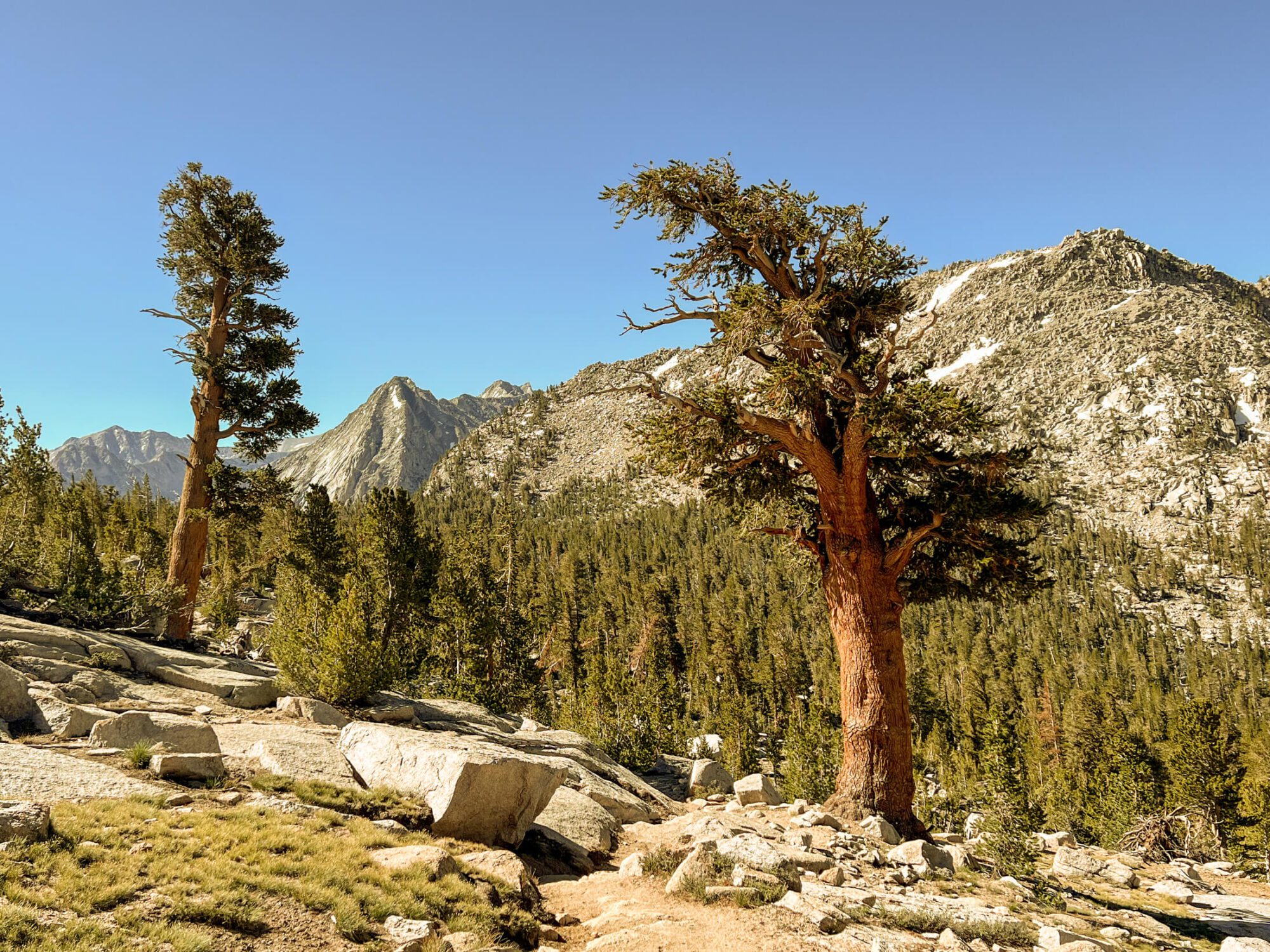
More time? Adapt the Itineraries!
Add a low KM day or zero KM day in the Rae Lakes and Arrowhead lakes alpine area to any of these itineraries to give yourself more time to explore. Maybe you spend the day relaxing lakeside or day hiking into the Sixty Lakes Basin (3 miles each way from Upper Rae Lakes). Remember, if you’re staying at Rae Lakes you’ll have to move your basecamp as camping is limited to one night per lake.
Itineraries too long? Break up a day. Camping is permitted almost everywhere on this loop, so break any of the days up into manageable chunks!
Packing List Breakdown
Hiking the Rae Lakes Loop is more enjoyable the lighter your pack. A lighter backpack helps you cover more mileage and more elevation with less effort making big days more realistic, not to mention more comfortable!
If you’re new to backpacking, don’t stress out about buying the latest and greatest equipment. Save money and use things you already own that can be repurposed for backpacking, rent gear, or borrow stuff from a well-equipped friend. Later, when you’ve gained more experience, modify your kit and change out gear as you get a better understanding of what you can and can’t live without.
Use the checklist below to click to navigate to a discussion of each individual item.
Permits & Red Tape
Essential Items
- Tent
- Backpack
- Sleeping mat
- Backpacking pillow
- Sleeping bag or quilt
- Water purification
- Trowel, TP, & Hand Sanitizer
- Swiss army knife
- Stove & fuel canister
- Lighter & Matches
- Backcountry cookset
- Water bottle or reservoir
- Water storage container
- First aid kit
- Trekking poles
- Bear Canister
- Headlamp with red light mode
- GPS, compass & map
- Battery back-up & charging cable
Luxury Items (optional)
Clothing and Accessories
- Shell jacket
- Puff jacket
- Sun hoodie
- Convertible hiking pants
- A pair of shorts
- Base layer top
- Base layer bottom
- Underwear
- Hiking socks
- Hat & beaniet
- Sunglasses
- Gloves
- Trail Runners or Hiking Boots
- Camp Shoes (optional)
- Low trail running gaiter (optional)
- Microspikes (season dependent)
Additional Items
Food
Permits & Red Tape
Wilderness permit
To backpack the Rae Lakes Loop, you require a wilderness permit for Sequoia/King’s Canyon National Park. For the typical route, you’ll need a permit starting from Bubbs or Woods Creek trailheads. You must pick up your permit the day before/morning of your hike from the Road’s End Ranger Station (see full discussion on permitted earlier in the post).
For alternate trailheads like Kearsarge Pass in Inyo National Forest, your require a wilderness permit for Inyo National Forest. While you don’t have to pick it up from a ranger station it must be printed and signed to activate.
National Recreation Pass
You need a national recreation pass to park to enter Sequoia/King’s Canyon National park. If you frequently recreate on public lands and national parks, get the America the Beautiful Annual Pass before your trip to save time.
Emergency Medical Insurance (for non-US persons)
If you’re traveling from outside the US don’t forget to purchase comprehensive travel insurance that includes emergency evacuation.
Check out World Nomads* for a quote. Hopefully, you never need to make a claim, but if you do you’ll be beyond happy you were prepared! I broke my collarbone traveling a few years ago, which hurt enough! I can’t imagine how much worse it would have hurt if I had to pay the $15,000 in medical bills out-of-pocket…
*We receive a fee when you get a quote from World Nomads using this link. We do not represent World Nomads. This is not a recommendation to buy travel insurance.
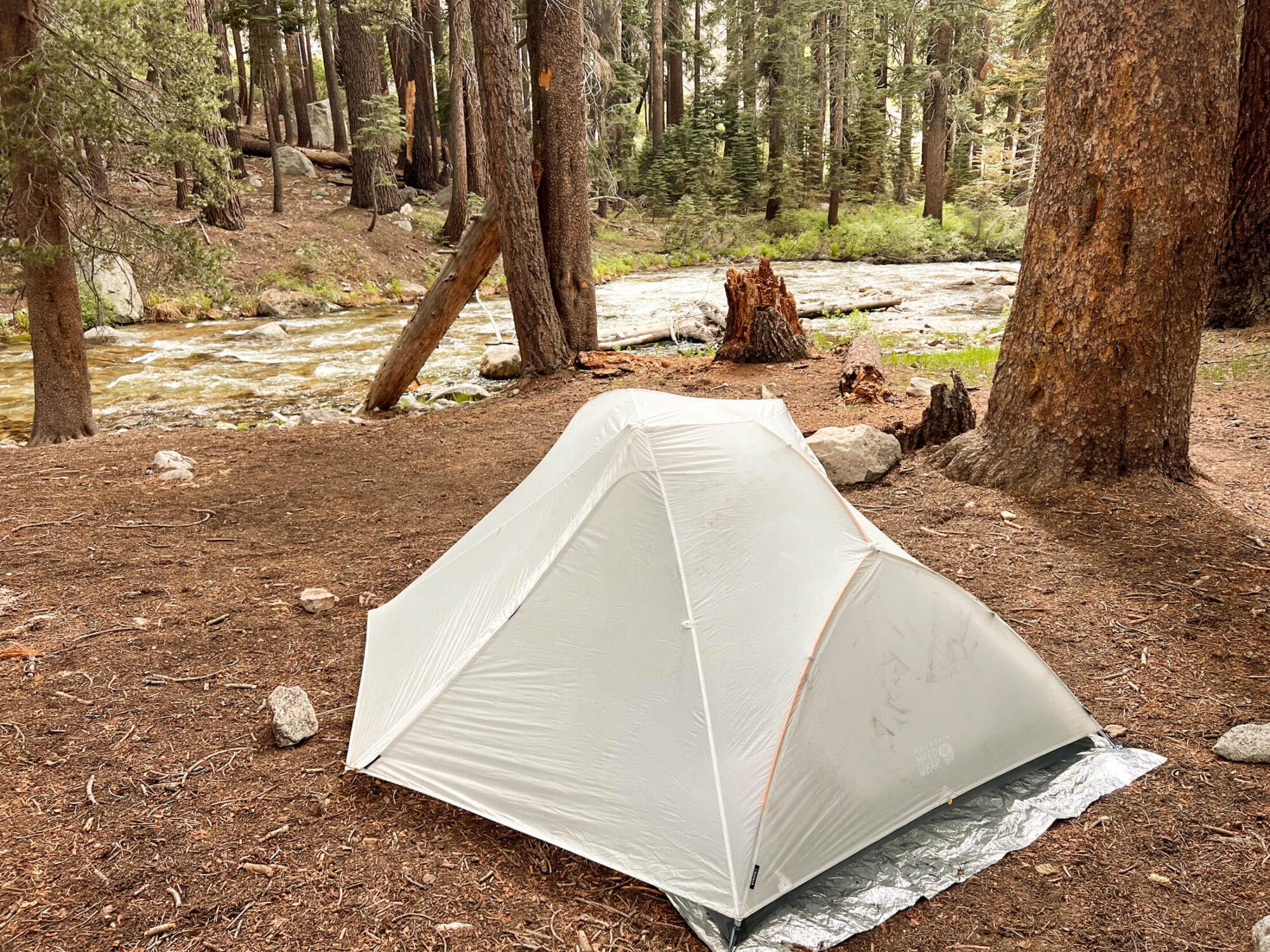
Essential Items
Tent
I’ve used the Mountain Hardwear Strato UL2 (view at REI / Backcountry) for several years including on the Rae Lakes Loop and it’s a great lightweight tent. It’s semi-freestanding, double walled and weighs in at a mere 2.5 lbs. Plus, unlike many 2-person tents, it doesn’t have a tapered floor allowing for 2 extra wide sleeping pads to fit side-by-side with no overlap! This tent is cozy, but workable for two and palatial for one! I believe this tent has now been discontinued, but check the links above to score a sweet deal. If you can’t find this tent, the Nemo Hornet Osmo is a similar, high quality semi-freestanding tent.
For a completely freestanding tent that offers a bit more durability and space, check out the Big Agnes Copper Spur UL2 (view at REI / Backcountry).
Lastly, if you’re looking for a trekking pole tent, check out the single wall Durston X-Mid Pro which weighs in at a mere 20 oz (565g). There’s a reason this tent has developed a serious cult following among PCT hikers and ultralighters.
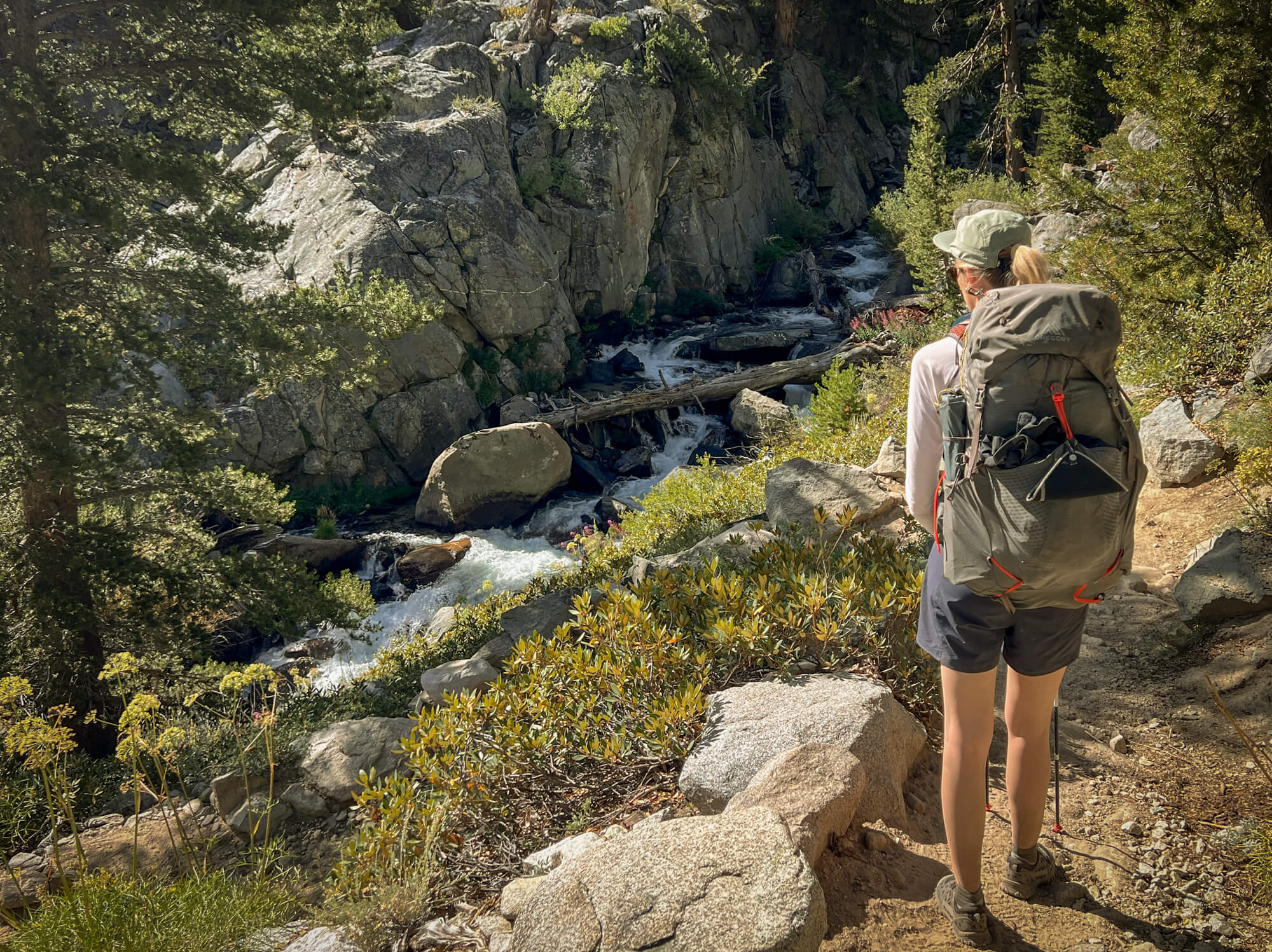
Backpack
If you’re just getting into backpacking, use any large-size backpack with a decent suspension system (and good hipbelt). Scope out a second hand shop or borrow one from a friend! Going this route gives you time to decide what features you need and whether or not backpacking is something you want to invest in. Whatever backpack you use, make sure you have a good fit before by following this guide to backpack sizing. When I first started backpacking, I used a 60L travel backpack, our Khmer Explorer Travel Set, on Canada’s West Coast Trail. While not designed for hiking, it worked great despite my ridiculous overpacking!
If you’ve begun dialing in your backpacking kit and moving towards a lightweight set-up, check out either the Osprey Exos for men (view at REI/Backcountry) or Gregory’s Facet for women (view at REI / Backcountry). At under 3 lbs these packs are a great compromise between barebones ultralight options and the heavier feature-laden packs. Their excellent suspension systems prevent the dreaded swampy/sweaty back on hot days.
If you’re an extreme gram counter, check out the Hyperlite 3400 southwest (view at REI / Backcountry). It’s 100% waterproof and constructed from ultralight dyneema fabric. Being ultralight you’ll sacrifice features, so if you hate getting a swampy back (that’s me) you may prefer the Osprey despite the weight penalty. Backpacking gear is always a zero sum game!
Sleeping mat
I used to have terrible sleeps in the backcountry until I switched to the Therm-a-Rest NeoAir X-lite (view at REI / Backcountry / Thermarest). It’s incredibly lightweight, comfortable, and packs down to the size of a Nalgene bottle. This is probably one of my favorite backpacking items! Get one. You won’t regret it. Rest well!
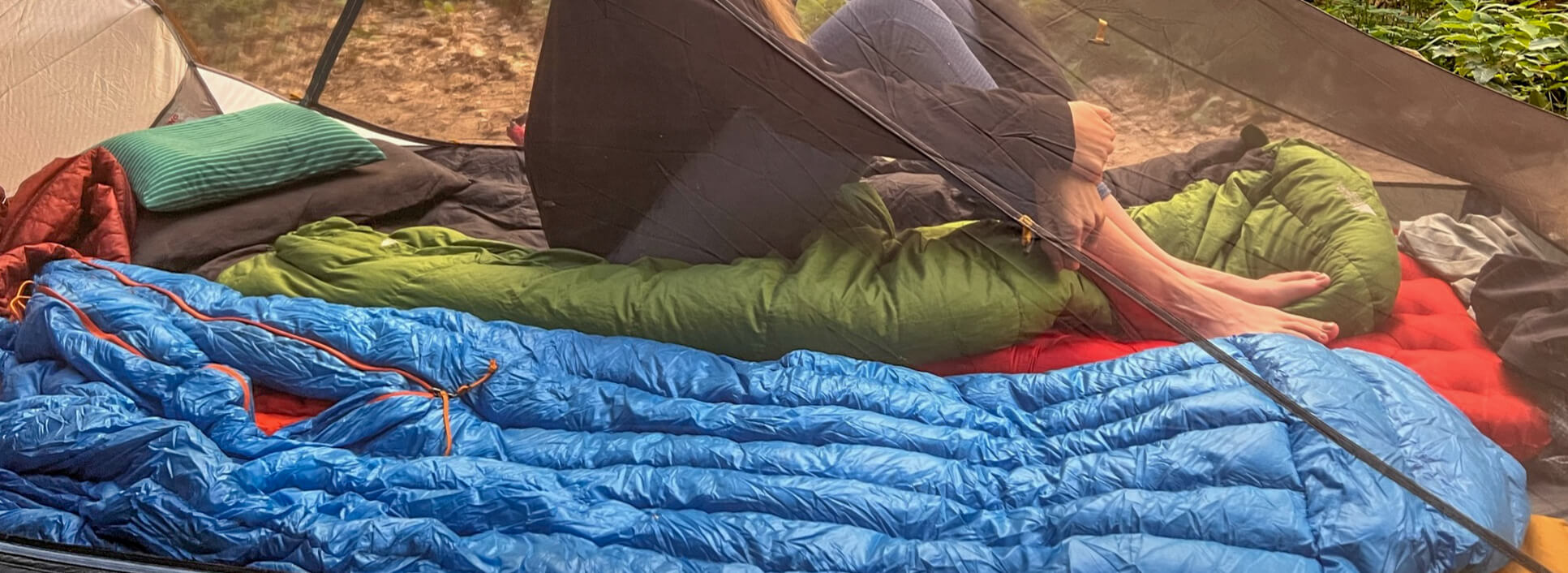
Sleeping bag or quilt
Patagonia’s sleeping bags are 5 star! I got one a few years back and it has been nothing short of perfect. Weighing only 822 g (29 oz) it’s lightweight and packs down small! I found the 30°F / -1°C to be perfect for most outings – if it gets colder you can always layer up! Like all Patagonia products, it’s not cheap, but they stand behind their gear and the quality matches the price point. If you spend a lot of time in colder environments they also make a 20°F / -7°C version . These bags are a worthwhile splurge!
For an even lighter-weight option, consider going for a sleeping bag quilt. Feathered Friends Flicker UL Quilt Sleeping Bag has won numerous awards and is a stalwart among ultralight backpackers. With a weight starting at 526 g (1 lb 2.5 oz), I can see why!
For a budget friendly bag that will last you for years, check out these great options from Big Agnes & Nemo Equipment. Bags rated to 30°F / -1°C should be well suited to this trip.
Backpacking pillow
Yes, you can sleep with a pillow not made of bunched up clothes in the backcountry. The Nemo Fillo Elite (view at REI / Backcountry) packs down ultra small and provides an unprecedented level of comfort after a long day on the trail. Once you try one you won’t imagine how you lived without!
Water purification
Trowel, Toilet Paper & Hand Sanitizer
The lack of facilities on the Rae Lakes Trail make a trowel a requirement for this trip. Follow minimum impact camping principles and be sure to dig a cathole a minimum of 6 inches deep and at least (200ft) away from any established trails, campsites, or water (creeks, lakes, rivers etc.). Pack out your TP. Don’t forget a small bottle (1 oz) of hand sanitizer.
Swiss army knife
For fixing gear or cutting food, bring a swiss army knife.
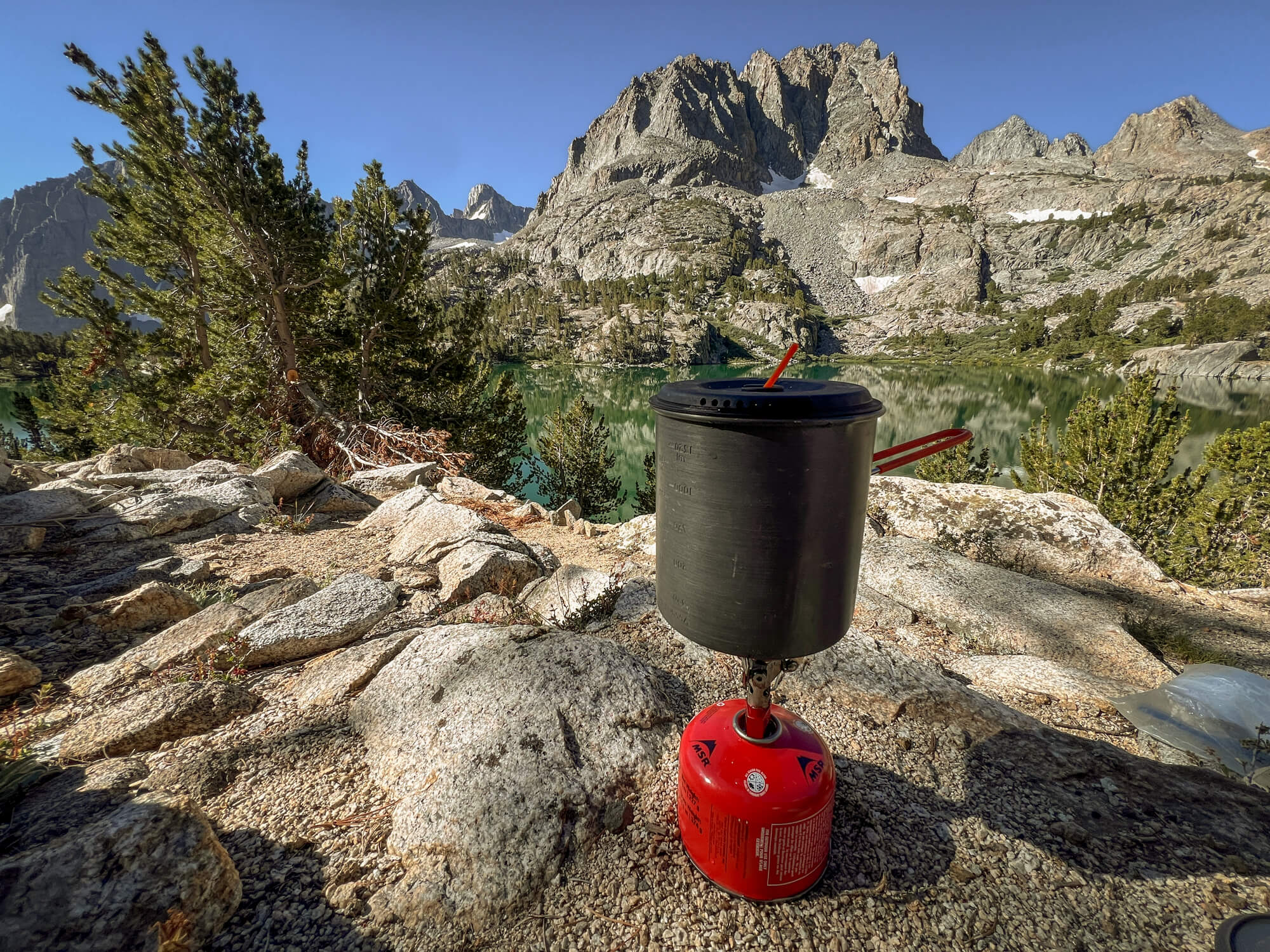
Stove & fuel canister
Lightweight, convenient, and reliable, the MSR pocket rocket (view at REI / Backcountry / MSR) has been my go-to backpacking stove for years.
Backcountry cookset
The GSI Halulite Microdualist II is a compact, lightweight two-person cookset that can fit an MSR pocket rocket and a fuel canister inside.
If you’re looking to buy a minimalist stove and cookset the MSR PocketRocket Stove Kit (view at REI / Backcountry / MSR) is an all-inclusive solution.
Lighter and matches
A baby bic lighter is all you need. I often bring a small pack of matches wrapped in ziplock bag as well for backup or bring a small pack of waterproof ones.
Water bottle or reservoir
Nalgene (Check options at Backcountry / REI) are the standard hiking bottle.. If you’re cutting weight or looking for a way to save a buck, a simple smart water is the go-to for ultralight backpackers.
Alternatively, a hydration reservoir (view options at REI / Backcountry) allows you to stay hydrated continuously without stopping to grab and open a bottle. The hoses sometimes leak though and they freeze up during chilly nights.
Water container
Extra water storage bags like the MSR Dromedary or Dromlite (view options at REI / Backcountry / MSR ) help make cooking and treating water easier by saving walks repetitive water gathering missions.
First aid kit
A first aid kit is an essential item to have for treating blisters, scrapes, and cuts,. The pre-built kits from Adventure Medical Kits (view at REI / Backcountry / Adventure Medical Kits) offer many options for party size and trip length. At the end of your trip, write down any items you used and replace them immediately so your kit is ready for your next adventure.
Hiking poles
Trekking poles help with the the big elevation changes on this hike! I resisted getting them for years, but take it from a former skeptic, poles are incredible at reducing the strain of long, grueling descents. Plus they providing extra stability on exposed sections. Do yourself a favor and get a pair of poles. I prefer the poles that fold up into a Z shape for their packability and weight. Leki (view options at REI) and Black Diamond (view options at REI) both make excellent options.
Headlamp
The Spot 400 (view at REI / Backcountry) has 6 modes including the night vision saving red light. Red light mode takes a minute to get used to, but once you do it’s a total game changer, Hello stars!!
GPS, compass & map
Download the GAIA app for maps and gps. I always bring a traditional compass and map as well in the case of technical problems or dead batteries.
Battery Back-up & Charging Cables
Keep your phone charged for photos and gps. One of these Zendure powerbanks is sufficient for 3-4 day trips.
Don't forget a Bear Canister
Bear canister’s are bulky and annoying, but they’re easy to use and the best way to keep your food and scented items bear safe. Rangers check for them when issuing your permit.
BearVault canisters are the most popular as their transparent design allows you to easily what’s packed where.
- Get the BV500 (view at REI / Backcountry) for 6-7 day solo trips or 3-4 days for 2 people.
- Get the BV450 (view at REI / Backcountry) for 3-4 day solo trips or weekend trips for 2 people.
Clothing & Accessories
Shell jacket
An essential piece for wind, rain, and snow. The Arc’teryx Beta shell (view men’s / women’s) is the best all around shell jacket. This shell performs in all adverse conditions and is the perfect outer layer for cool Sierra nights or stormy afternoons. Arc’teryx gear is expensive, but impeccably designed. I was skeptical for years, until I purchased a few pieces of their trail running gear and got hooked. If you’re looking for the best reviewed hiking shell out there, this is the one.
For another excellent option that is more economical, check out the Patagonia Torrentshell 3L. (view men’s / women’s)
Puff jacket
I’ve had the Patagonia Nano Puff Hoody (view at REI / Backcountry / Patagonia) for years and it works great on it’s own or underneath a shell for extra warmth. It’s a perfect multi-functional item for everyday, backpacking, and pretty much anything where you might need a bit of warmth. I’m still looking for an activity it doesn’t work for.
Rainpants
Mountain weather can change fast and rain pants can be a lifesaver in your backpacking kit. Many have the functionality for quickly taking them on and off without removing your shoes/boots allowing you to stay comfortable even if you get caught in a sudden downpour. I’ve been happy with the Black Diamond StormLine Rain Pants (view at REI / Backcountry) For a budget option check out the REI branded rain pants.
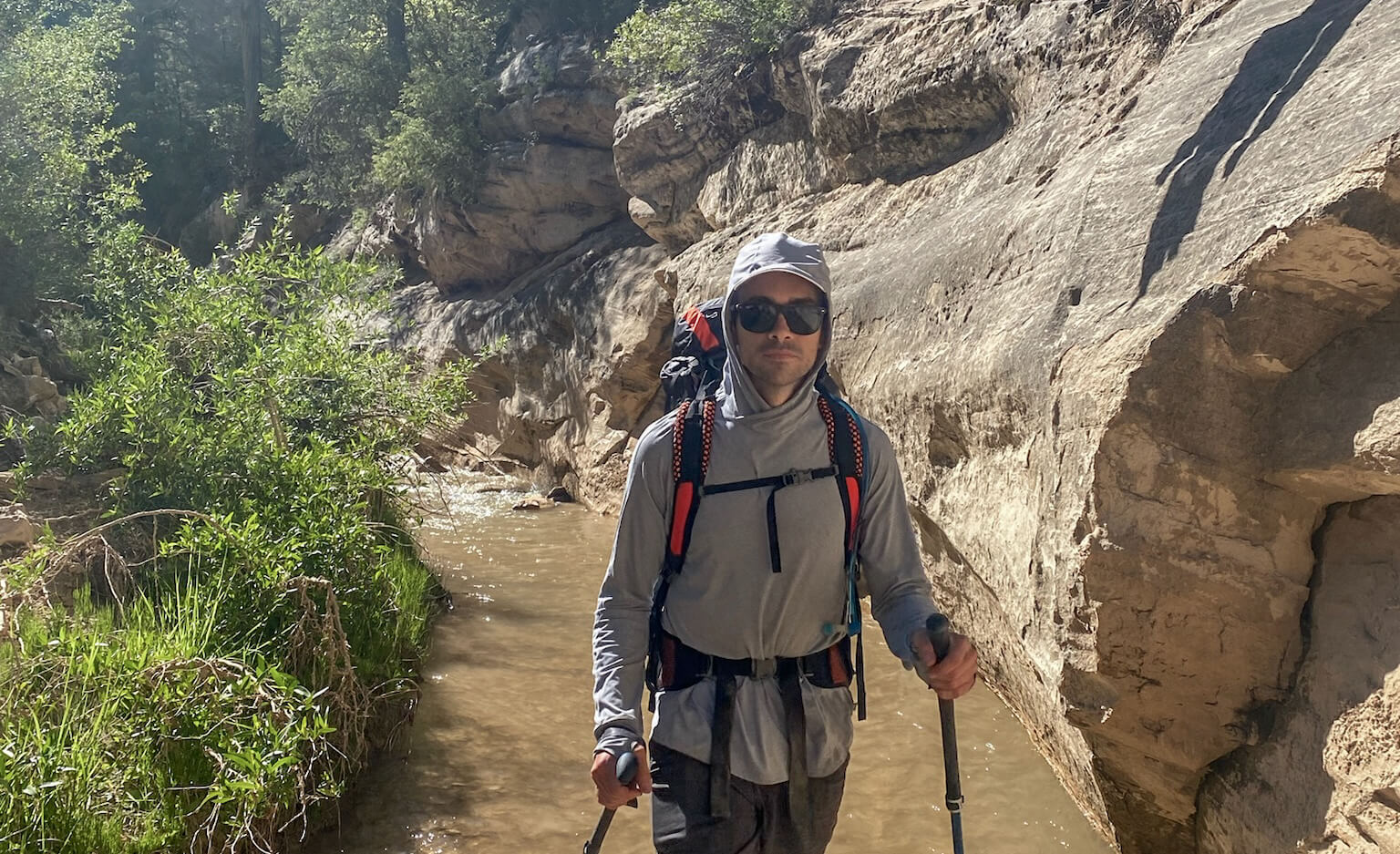
Sun hoodie
When I was backpacking the Grand Canyon a few years back, I was shocked to see throngs of Arizona Trail thru-hikers wearing hoodies in the 100 degree (40 C) heat. Turns out they weren’t lost tech bros in the Grand Canyon, they were onto something! A sun hoodie has been one of the best items I’ve added to my backpacking kit. They keep you burn free, are surprisingly cool, and let you get away with leaving the bottle of sunscreen at home (or bringing way less). The Sahara Sun Hoodie from REI is literally the only shirt I wear backpacking now.
Convertible hiking pants
Personally, I like zip-off pants. They’re goofy, some people complain about the zippers, but you don’t know until you try! Try the Patagonia Quandary Convertible Pant (view at REI / Backcountry / Pataognia) and find out for yourself.
For women, check out the non-convertible Gamma Pants by Arc’teryx for a great all around hiking and mountain pant. (My wife likes them).
A pair of shorts
In addition to hiking pants, it’s nice to have a pair of shorts to change into after a long day on the trail or as a backup option. Trail running shorts are light and comfortable.
Base layer top
Base Layer Bottom
A merino bottom baselayer is perfect for warming up at night or during chilly mornings.
Underwear
These underwear work well for hiking, trail running, mountain biking and skiing. They dry fast and I’ve found them to be more durable than the more expensive ones from lululemon. I usually bring a 2-3 pair depending on trip length.
Patagonia also makes women’s underwear, but I am unable to advise on fit, form, function, or durability on this front.
Hiking socks 3 pairs
I pack 3 pairs of socks. 1 pair for hiking, 1 pair to change into at camp, and a reserve to throw into the rotation as needed. Darn Tough Vermont make the best hiking socks hands down. They’re guaranteed for life/replaced free of charge and they don’t stink. So go ahead and try to get holes in your socks, they’ll give you new ones.
Hat
A ball cap (view at REI / Backcountry) or tilley hat keeps your face protected from the intense mountain sun.
Beanie
Bring a beanie for variable mountain weather, they’re perfect for chilly mornings or evenings.
Sunglasses
Pack your favorite pair, the sun gets intense at these elevations!
Gloves
I bring a thin weatherproof pair of trail running gloves, the Black Diamond Mount Blanc.
Trail runners or hiking boots
Unless you’re hiking in the winter with the potential for snow or you’re carrying gear for your whole family, I’d choose trail runners for this hike. I’ve had great luck with the both the La Sportiva Bushido II (view at REI / Backcountry) and the Altra Mount Blanc Trail Shoe. The Altra’s are supremely comfortable and my current favorite hiking shoe, but make sure to take some time transitioning into them before doing a major hike. These are a zero-drop shoe and diving in headfirst is likely to cause abnormal muscle soreness.
If you insist on sticking to a hiking boot, consider a lightweight model like the Scarpa Rush.
Camp shoes
Crocs (view at Backcountry / REI) are back! Well for backpacking camp shoes they never left… They’re lightweight and ugly as ever. I usually just loosen my trail runners to avoid packing camp shoes, but many backpackers find these to be the perfect camp shoe for resting sore feet after a long day.
Low gaiters
Low gaiters can help keep rocks, sand, and snow out of your trail runners and save you from blisters. I don’t pack these, but some hikers like them.
Microspikes (Season Dependent)
Kahtoola Microspikes (view at Backcountry / REI) slip effortlessly over your boots and make walking on snow and ice a breeze. If you’re tackling this hike early in the season bring a pair along, especially for Glen Pass.
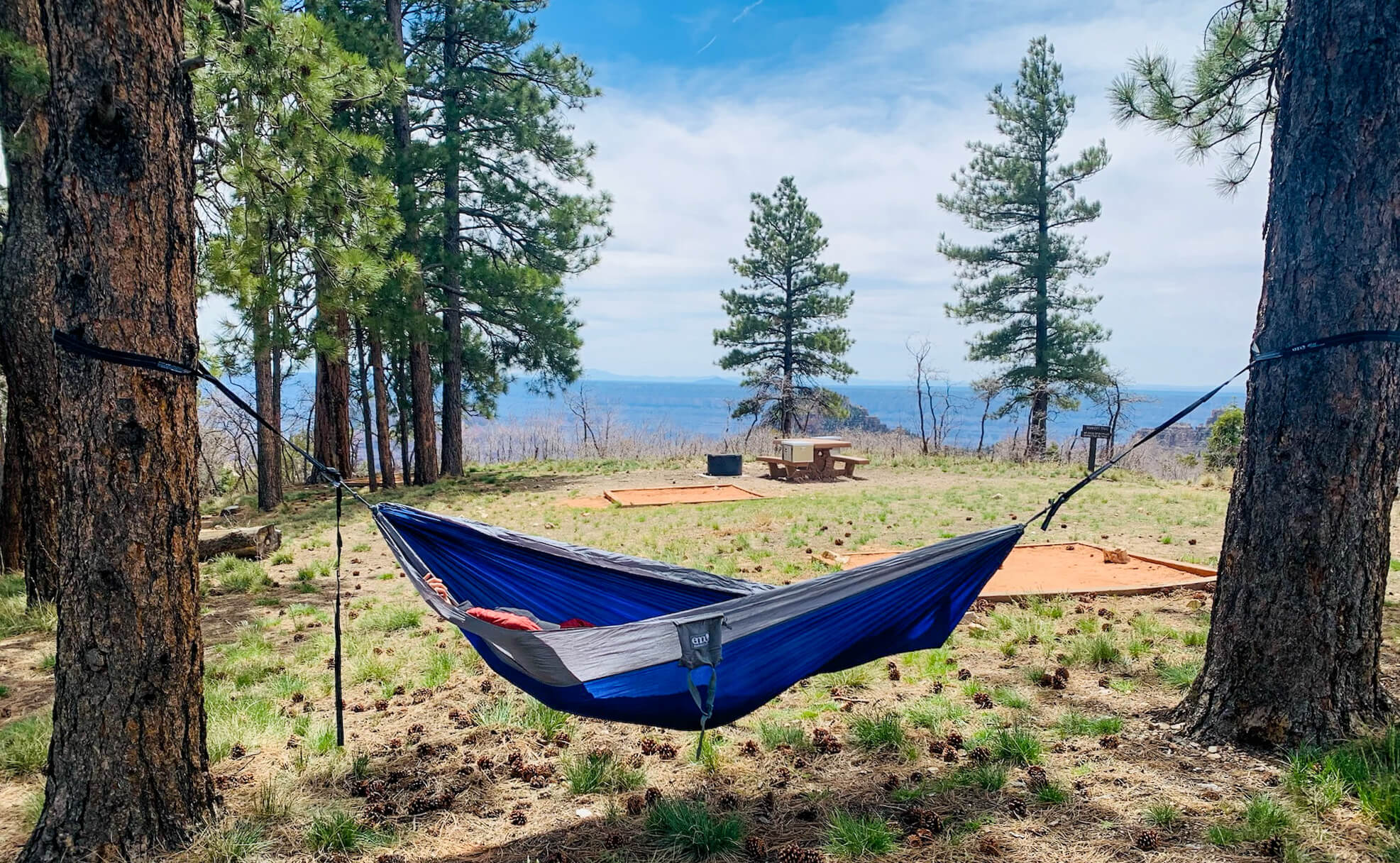
Optional Luxury Items
These items are luxuries that add weight, but may be worth it if you plan making base camp somewhere for a few days.
Hammock
If you’ve never strung up a hammock between two trees deep in the backcountry, you’re missing out! Nothing beats getting horizontal with some great reading material in the pre-dinner hours or taking in an amazing sunset from your own outdoor couch. The ENO Double Nest (view at Backcountry / REI) has room for two and at ½ kg is easy to justify on this trip! Don’t forget the straps are sold separately (view them at Backcountry / REI).
Camp Chair
After a long day on the trail, there’s nothing better than finding a nice comfortable spot to rest your weary glutes. The Helinox Chair Zero (view at REI) is a great option and at just over 1lb, it’s light enough to justify bringing on slower/easier backpacking trips where weight isn’t as big of consideration or for trips from an established base camp.

Additional Items to Pack
Sunscreen
The sun is extra intense at these high elevations, so don’t forget sunscreen! If you’ve followed my advice about using a sun hoodie, you won’t need to pack much. I prefer mineral based sunscreen, like this one. Plus they’re small, easy to pack and won’t leak all over your gear. If you need even less, they offer a face stick as well.
SPF lip balm
Burnt and dry lips aren’t fun. Avoid the misery by packing SPF lip balm.
Bug Spray
In early season the bugs can be brutal on this hike, so don’t forget bug spray. I hate how DEET bug repellent feels on your skin and how easily one leaking bottle can destroy the coating on your expensive outdoor gear, use this Picaridin Insect Repellent instead!
Toothbrush
If you start contemplating cutting down the shaft of your toothbrush handle to shave a few grams of weight off, you’ve now become a maniacal gram counting ultralighter. No, this practice is not uncommon.
Toothpaste tabs
No need to carry a tube of toothpaste, save the weight by counting out the exact number of toothbrushing sessions your hike requires then pack that number of toothpaste tabs.
Duct tape
Duct tape isn’t just your dad’s favorite tool, it also works great for gear repairs and blisters! Take some off a big roll and wrap it around a toothpick or buy this small pack.
Food
I try to avoid the pre-packaged, just add boiling water meals to save a few bucks. However, if you’re extremely strapped for time or just getting into backpacking, they do serve a purpose. If you go this route, I’d suggest the meals from GOOD TO-GO, they use fantastic ingredients with no additives or preservatives.
As another option, head to the grocery store and search for things like lentil rice, ramen, or mac & cheese. Pretty much any item at the grocery store that is dried and requires only boiling water is an easy and less expensive route to go. Always repack this type of food as there is no reason to carry unnecessary packaging/weight on the trail.
If you want to take your backcountry culinary experience to a whole new level, make your own food from scratch. This let’s you control portion sizes. protein content, nutrition, and flavor. It’s also surprisingly easy with a bit of planning. Pickup this dehydrator and a copy of The Dehydrator Cookbook for Outdoor Adventurers and you’ll be a gourmet backcountry chef in no time!
How to pack the right amount of food
To pack the right amount of food for backpacking pre-planning is critical. These are the steps I follow to get my menu organized before a trip:
- Create a list with each day you’ll be on the trail as a header. Ex. Monday, Tuesday, Wednesday
- Create sub headers within each day for the following categories: Breakfast, Snack 1, Lunch, Snack 2, Dinner
- Purchase/make food to fill in every blank on the list and write each item down as you accumulate it. Add a couple extra bars or an extra dinner as buffer for emergencies.
- Repackage all bulky food. Puncture large air pockets and place items in ziplocks.
- Lay everything out by day and subcategory in your kitchen, living room, or wherever you have room. This serves as a final check against forgetting anything and makes packing easy.
- Once you’ve confirmed you have everything, load it into your bear can in reverse chronological order (last day goes in first to the bottom of the can). This helps minimizes digging through your bear can on the trail.
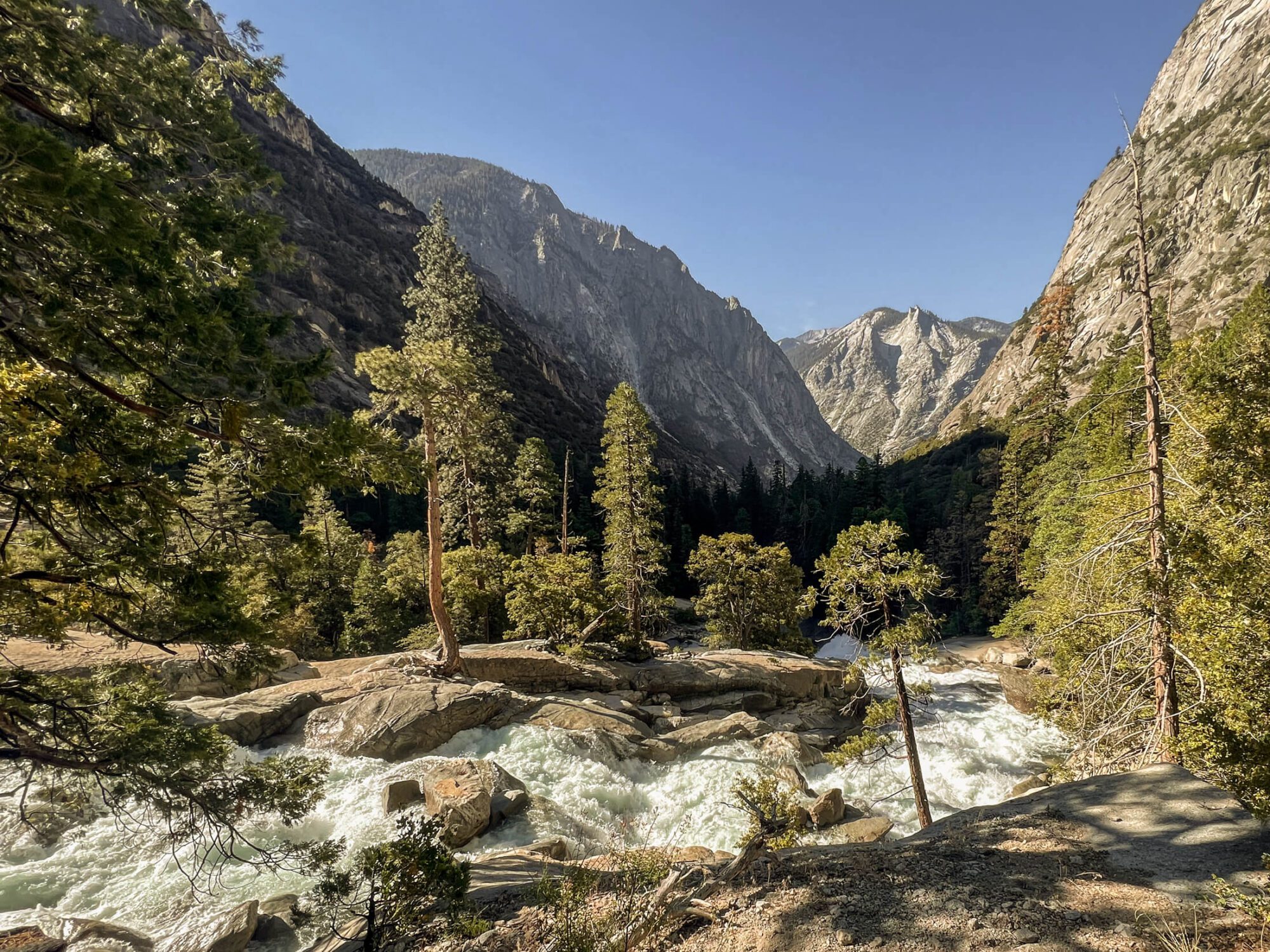
Final thoughts on hiking the Rae Lakes Loop
- The Rae Lakes Loop was an absolutely spectacular backpacking trip.
- Completing it in 3 days was manageable, but day 1 was long.
- JMT and PCT section from Woods Creek Bridge to Lower Vidette Meadow felt very busy due to thru hiker traffic.
- Bugs were pretty bad at times in early June. Saw hikers with face nets.
Your Thoughts on Rae Lakes
Have you hiked the Rae Lakes Loop? I’d love to hear from you. Questions about backpacking Rae Lakes? Drop me a line in the comments below and I’ll do my best to help!

